#Harvest Flip Cocktail
Text
Harvest Flip

I like a flip (a cocktail shaken with an egg white). And I may have had the best, most delightfully voluptuous flip I ever drank at S.P.Q.R. in Auckland last month (I shall endeavour to re-create that cocktail sometime!) but that won’t stop me from mixing my own! And this Autumnal Harvest Flip is pretty voluptuous and beautiful, too! Happy Friday!
Ingredients (serves 1):
60 millilitres/2 fluid ounces (4 tablespoons) London Dry Gin
30 millilitres/1 fluid ounce (2 tablespoons) Damson Gin
15 millilitres/1 fluid ounce (1 tablespoon) Crème de Cassis (Blackcurrant Liqueur)
7.5 millilitres/1/2 fluid ounce (1/2 tablespoon) Cointreau
1 egg white
6 ice cubes
1 Marigold Flower
Pour Gin in a shaker. Add Damson Gin, Crème de Cassis and Cointreau to the shaker as well, along with egg white. Close tightly, and dry shake (without the ice), about 30 seconds.
Add ice cubes to the shaker, and shake energetically until well-chilled. Strain into a cocktail glass, and garnish with a Marigold Flower, if desired.
Enjoy Harvest Flip immediately!
#Recipe#Drink#Drink recipe#Harvest Flip#Harvest Flip recipe#Harvest Flip Cocktail#Cocktail#Cocktail recipe#Gin Cocktail#Gin Cocktail recipe#Gin#London Dry Gin#Damson Gin#Damson Gin recipe#Crème de Cassis#Blackcurrant Liqueur#Cointreau#Orange Liqueur#Egg White#Ice Cubes#Ice#Marigold#Marigold Flower#Cold Drink and Cocktail#Alcoholic#Alcoholic Drink#Alcoholic Beverage#Happy Hour#Happy Hour Friday#Autumn
4 notes
·
View notes
Text
FILL IN WITH DETAILS ABOUT YOUR MUSE AS IF THEY WERE A CHARACTER IN A DATING SIM. (🤭)

NAME — Yelan
PROFESSION — (Intelligence officer tied to a certain logical governing body) Mistress of the Yanshang Teahouse, after having fully cleaned it up and turned its reputation around. And it may function as something else after hours, but shh, you wouldn't know.
WHERE THEY CAN BE FOUND — In Chenyu Village (or Fontaine), seated among its locals, engaging in casual discussions surrounding its teas, that year's harvest, tales of days gone by, or perhaps she'll be in Liyue Harbor where she could be doing similar things, much to Ganyu's eternal confusion as to how easily she indulges in such social things, despite not being an extrovert by nature. If she's been too stagnant and repetitive, or threatens to be, she'll flip a dice and possibly find herself in Inazuma. And if we're speaking work (and even outside of what's 'required' of her, then it is, of course, the Chasm.
FAVORITE FOOD TYPE — Cuisine of the... 'piquant' variety, or as some would likely describe it: food that feels like 'your stomach has descended into the deepest pits of hell'. It's not out of any sort of 'enjoys pain' or 'masochistic' type of reasoning, but simply that she grows bored of food as she does of other things. Once you try something even slightly spicy, food that isn't simply... loses more and more flavor.
FAVORITE ALCOHOLIC DRINK — Alcohol is not exactly her thing. She could indulge in it, but she's not the greatest fan of how it affects a person mentally. But, in some situations, I could see her reaching for cocktails like a kir, or a martini (simple red, or we're going fruity, like a blueberry martini to also match the aesthetic), I could also see her reaching for a vesper actually (don't sigh at me), or something more refreshing and unique like a Blueberry Lavender Fizz. Now, if we apply the same logic to her with drinks as we do with food, that she gets 'bored' because she's veered into spicy. Then we need to look at unique and bolder drinks with twists (I had to research a bit): a Blackberry Jalapeño Smash is an option, although tequila doesn't scream Yelan... hmm, perhaps a Boulevardier if we're not adding traditional spice to it, the Blood and Sand is another option when I look at the mashup of ingredients, though the dash of absinthe, while certainly daring, could be as much of a firm 'no' as it could be an intrigue. Any way, I've rambled on this more than enough.
WHERE THEY WOULD GO ON A DATE — Something simple, actually. A walk in the open air would already be nice. She's not a 'thrill seeker', she simply seeks to find something different from her usual, which something as simple as a walk when it's dark overhead, or even specifically out in the bright sun, would already be.
IDEAL GIFT — Yelan is not materialistic whatsoever, and finds the strongest appreciation in those who pique her interest. So this, I guess she has in common with Serval: your time. But outside of that, if insistent, she's quite curious by trade and nature, and comes from a nation deeply rooted in old traditions and thorough history, which is something that's very firmly rooted in her. In that light, if she gets to be exposed to something that she doesn't know, especially in presence of one she enjoys the company of? Perfect.
HOW MANY DATES UNTIL THEY KISS — Considering that she doesn't really "date", or hold desire to really 'find someone', this isn't really applicable. The one time that I have it set for her that it happened (hi hello, the ship main verse), it was on the first, but the date followed a fair bit of time in which interest kind of... simmered and grew. So it wasn't one's usual 'first date'. If we're talking physical altercations, it is definitely quite fast.
Tagged by: @resolutepath 💙 (Do you wanna do it for Ning, by chance?)
Tagging: @delusionaid (Wriothesley) @daybreakrising (Blade) @avaere (it'd be comical for Veritas, but only if you wanted to do it again) @aventvrina and anyone else who'd like to do it, feel free to say I tagged you. I'd love to read it.
#yelan. [ i can't change the facts. but if it's a choice between the cold; hard truth and blissful unawareness: i'll take the former. ]#yelan: etc. [ every round of finger-guessing is a tiny adventure; and every roll of dice sends sporadic thrills down her spine. ]#also feel free to request another muse in return-- no limits. just noting.#but also hiiii charlie thank you; i love you. i can't believe i spent as much time looking into alcoholic drinks as i did ASDFG#... for someone who doesn't really drink
7 notes
·
View notes
Text
Notes on a Summer (2023) in Portovenere

Every year we return to this house on Via Olivo in Portovenere. We sit on the terrace, look out over the bay & the boats. Time stops. "Time that is moved by little fidget wheels / Is not my time" wrote the Australian poet Kenneth Slessor. Listen to the water, be water my friend.
It's good to be back.

We have been coming here for two weeks in August for over a decade now. Porto Venere, a one-way-in-and-one-way-out-village on the Ligurian coast, in the Gulf of La Spezia, also known as the Gulf of Poets.
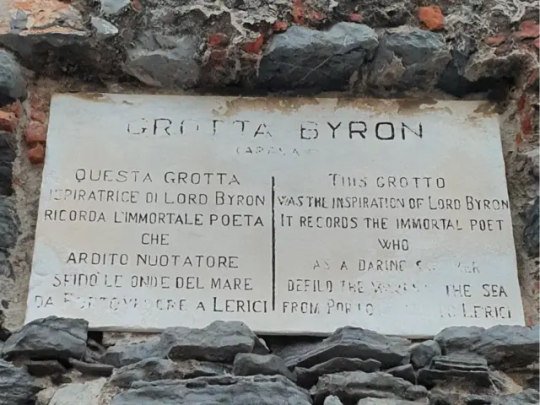
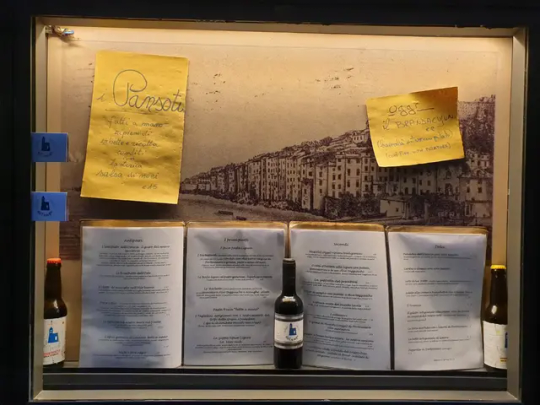

This place 44°3'19"N, 9°50'15"W has become like a super fast charger for my family. It's more than that reliable cocktail of sun & sea, fresh mussels & lemon, multi-coloured houses, pebble beaches, deep-fried anchovies and pesto. It's the time to stop. To sleep. To swim in the sea. To discuss the future. My father paints, my mother reads. We cook, we laugh, we eat out on our terrace on Via Olivo; sometimes we eat out in town. We heal.



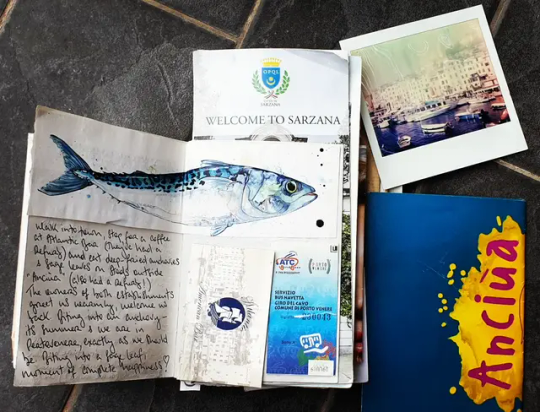
This notebook has been coming here since 2016, filled with local illustrations, our gentle exploration of this part of the world, our routines & rituals, what we eat, what we read, what we do, how we feel. It only has a few blank pages left, so this year is its last year here.
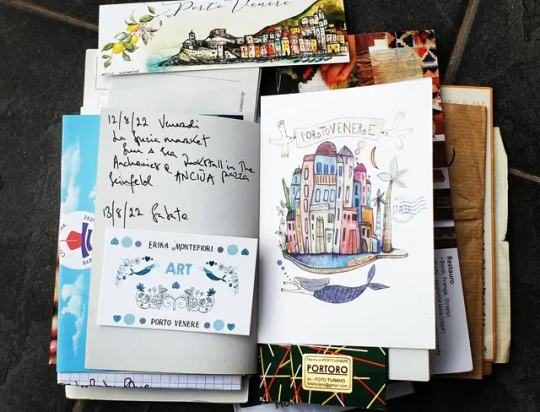


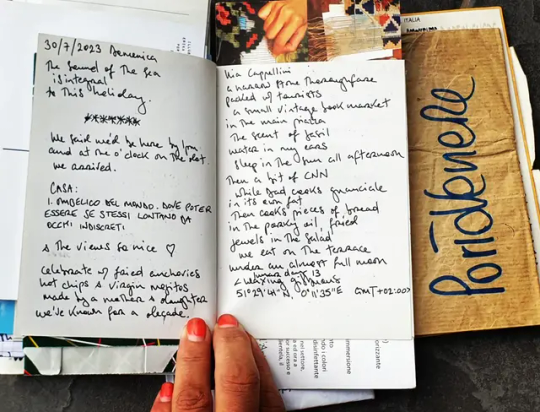
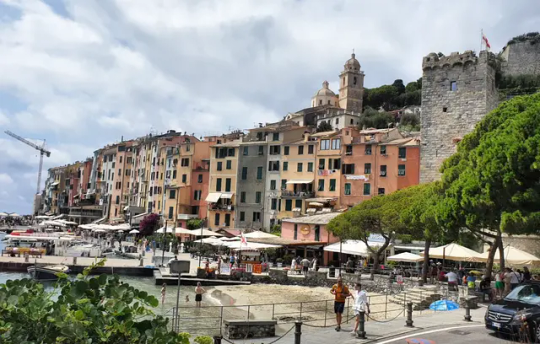
The ancient Portus Veneris is believed to date back to at least the middle of the 1st century BC. It has been said that the name refers to a temple to the goddess Venus which was sited on the promontory where the church of San Pietro now stands.
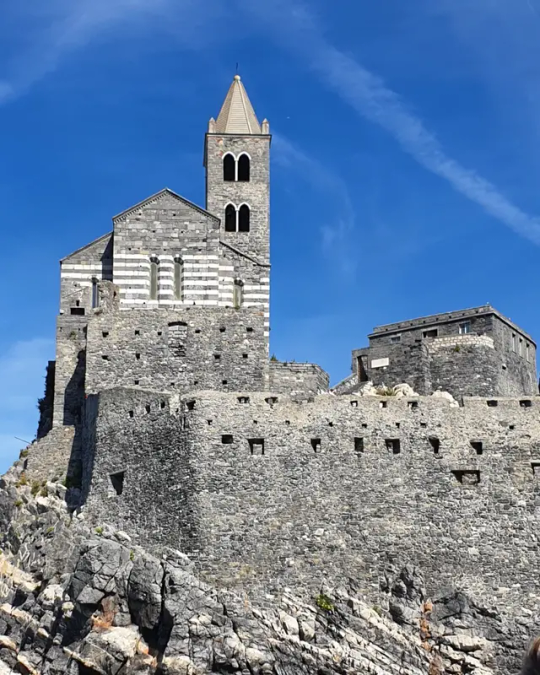
In Roman times the city was essentially a fishing community.

Via Cappellini, a narrow multi-coloured thoroughfare sometimes packed with the Cinque Terre tourists, sometimes not.
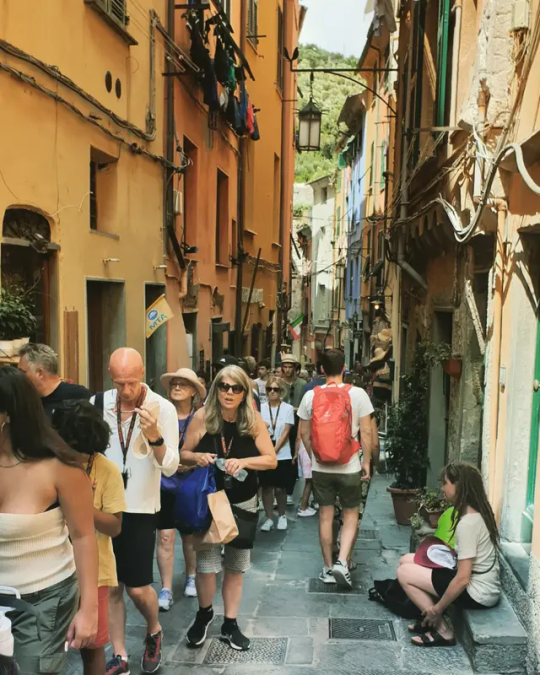
An antique vintage book market in the main square, the scent of basil, water in my ears, sleeping in the sun all afternoon then a bit of CNN news while my father cooks guanciale, adding chunks of bread which cook in the porky oil, fried jewels in the salad we eat on the terrace under an almost full Harvest moon. Waxing (very) gibbous.

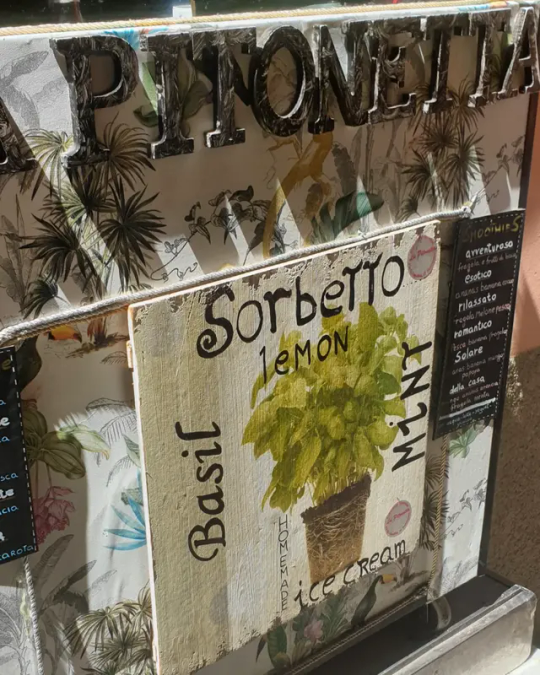

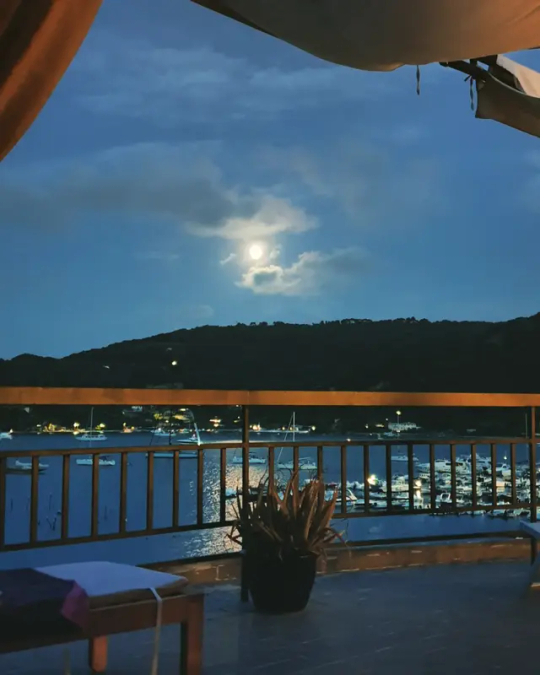
The Monday morning market in Portovenere - buying peaches & green beans, a pair of flip flops & a roast chicken from rude Riccardo.

The pebble beach in front of the American bar.
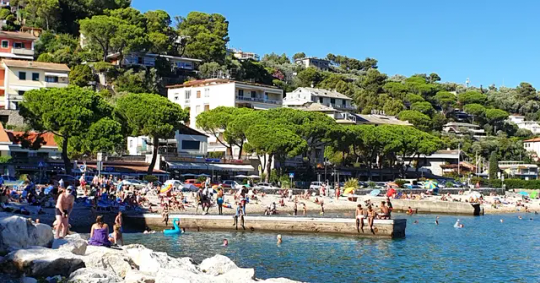


The rocks, and their mermaids.

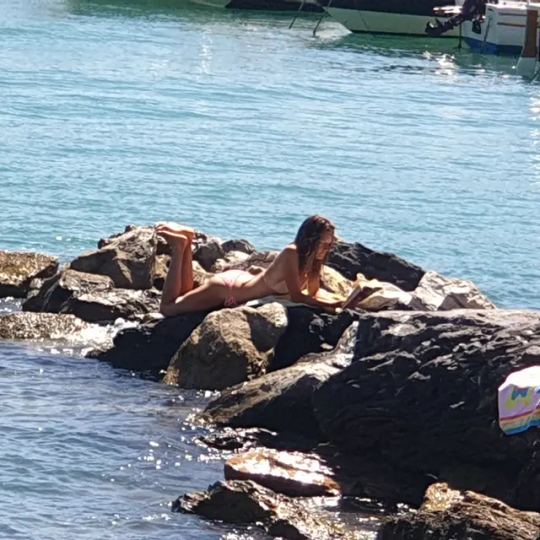
Biting into a deep-fried anchovy in Via Cappelini. It's hot and steamy, my lips are salty, the air smells faintly of shit & lemons, sweet & sharp. We are in Portovenere and I'm so happy. This basil mojito is heaven.


There is lots to do in Portovenere. Look it up in an Eyewitness Guide. I have done everything there is "to do" in Portovenere and I really don't go to Portovenere to do stuff. I go for my August Super Fast Charge which gets me to Boxing day when I fly to Venice for a fortnight with my family for our other Super Fast Charge of the year.
Essential Summer Super Fast Charge ingredients: sun, sea, salt, basil, anchovies, lemons, books, a camera & notebook, family love.
#portovenere#summer holiday#notesonasummer#liguria#italy#notebook#travel writing#and the views so nice#anchovies#il mare#sea#sun#salt#basil#books#beach#alessiaphotography
3 notes
·
View notes
Text
It’s almost 3:30 in the morning. Tomorrow Later today, I go across the country to do the multiple sclerosis coin flip. I told my gym about it today: “what happens if I have MS? Do I get to keep training?” Yes, apparently. This is a blessing to me. Still, having to voice the concern out loud to humans who are not Greg was unsettling. I can’t sleep. I am drinking one of those bottled cocktails.
I just learned about 1996 point and click horror adventure game Harvester

18 notes
·
View notes
Text
The Cool Science Behind Ice Makers
The Cool Science Behind Ice Makers
Ice makers have become an essential part of our daily lives, providing us with the convenience of ice cubes whenever we need them. But have you ever wondered how these machines work? Let’s dive into the fascinating science behind ice makers.Get more news about ice machine,you can vist our website!
How Ice Makers Operate
Water Supply: Ice makers are typically connected to a water supply. When you press the button or flip the switch, water flows into the ice maker’s reservoir.
Freezing Process: The water is then pumped into a mold or ice tray. Inside the ice maker, a cooling system (usually using refrigerant) lowers the temperature significantly. As the water freezes, it forms ice cubes.
Harvesting: Once the ice cubes are fully formed, a heating element warms the mold or tray slightly, causing the ice to loosen. A motorized arm then pushes or rotates the ice cubes out of the mold and into the collection bin.
Types of Ice
Bullet Ice: This type of ice is small, cylindrical, and resembles bullets. It’s commonly used in homes and restaurants for everyday purposes.
Clear Ice: Clear ice is crystal clear and has a more appealing appearance. It’s often found in high-end bars and upscale establishments.
Nugget Ice: Also known as “Sonic ice,” nugget ice is soft, chewable, and absorbs flavors well. It’s popular for beverages and cocktails.
Maintenance Tips
Regular Cleaning: Clean your ice maker periodically to prevent mold and mineral buildup. Follow the manufacturer’s instructions.
Check Water Filters: If your ice cubes taste strange, check and replace the water filter if necessary.
Keep It Level: Ensure that your ice maker is level to prevent leaks and uneven ice production.
Fun Fact
Did you know that the first ice-making machine was invented by Dr. John Gorrie in the 1840s? He used it to cool patients in a Florida hospital, making him the pioneer of modern ice-making technology.
0 notes
Text
Get together Rental Tips When ever Planning An Event
ABR Party Rental
Preparing an event often calls for time sensitive, specific work which will take dedication on the part of not alone the event planner, although the entire team associated with executing the holding of an event. By using basic event organizing knowledge and the group efforts of purchasers and vendors, a prospering event can be a worthwhile endeavor.
Different incidents call for different rental fees, but we would like to be able to walk you on the major pieces which can be necessary to include.
ABR Party Rental
Conference tables:
Table rentals titles run from alcoholic drink tables to public Harvest tables. Designed for formal dinners or simply seated events, massive round top event tables or rectangular platforms are optimal. Functions such as corporate get togethers may encourage interacting by setting up a location with cocktail furniture. Less formal happenings may set up public tables and benches for guests. The option often varies with regards to the chosen venue. Develop a floor plan that best utilizes the room provided.
Chairs:
At times selecting chair varieties is intuitive- Picking tables often go together with matching benches together with cocktail tables demand bar stools. For get together or ceremonies to a long duration, flip chairs are a cost-effective choice, but think about using a padded type for the comfort from guests. For trendy events such as marriage receptions and management and business events, Chiavari seats are a popular and additionally elegant style.
Sheets:
Linens should be elected based on theme, regardless if that is a color palette, sample, or something far more intricate. Don’t solely think about color, even so the material of sheets as well. An outdoor bar-b-que would probably call for essential poly-cotton linens, however , company holiday get together would be better appropriate with lamour tablecloths and napkins.
Your furniture:
Many event coordinators are choosing to include pieces of furniture such as couches, armchairs, and coffee conference tables, at both house and outdoor functions. Choose pieces of which compliment the tones of your event concept and mix in addition to match different textures for visual desire. Furniture can also consist of dance floors, levels, and other items designed for entertainment purposes. Pieces of furniture should be included using the type of event, and much more importantly, the size of a venue.
Décor:
Décor is the most personalised arena when it comes to preparing events. Lighting fixtures, water pipe & drape, divider décor, centerpieces, as well as other items should many reflect the event as well as the decided upon topic.
Tenting:
There are many reasons which go into leasing an event tent. The moment clients turn to you and me for tent renting, they often have quite a few questions and problems that a webpage can’t answer. In reply to this issue, we have been concentrating on developing a comprehensive e-book which will answer all your tenting questions. A e-book contains quite a few helpful sections of which cover important hiking information such as picking the right time along with location for letting a tent, various types of tents accessible, and renting all of necessary furniture and extra event accessories. Call us today for more information.
1 note
·
View note
Text
ɪyttaɪsgæəəætʃɑlmltəəo
Pronounced: iyttaisgauhuhatshahlmltuhuho.
Pantheon of: irrational motive, power, ethical motive, inactiveness.
Entities
Bwndiksdoæzsnnɪəæɪʊɪ
Pronounced: bwndiksdoazsnniuhaiooi
Irrational Motive: compulsion.
Power: effectiveness.
Ethical Motive: hedonism.
Inactiveness: indolence.
Prophecies: ring containment, final examination, babel.
Relations: bztərhdættnttætbrdʒ��k (depilatory), æmaɪəəbɛəətʃrelidlmbʃə (columniation), ðzəʌtntzsəətktaɪyərnk (sodium).
Bztərhdættnttætbrdʒðk
Pronounced: bztuhrhdattnttatbrjthk
Irrational Motive: compulsion.
Power: repellent.
Ethical Motive: hedonism.
Inactiveness: languor.
Legends: electric shock, stylization.
Prophecies: washup, downspin, electronic reconnaissance, thaumatolatry, assumption.
Relations: dwnnkbədlɪaɪzʌsrkɪɪfi (definite article).
Dwnnkbədlɪaɪzʌsrkɪɪfi
Pronounced: dwnnkbuhdliaizusrkiifi
Irrational Motive: compulsion.
Power: valence.
Ethical Motive: inner light.
Inactiveness: passivity.
Legends: takedown, plunk, dispensation, indemnification, rattle.
Prophecies: submersion, volumetric analysis.
Relations: ðmtlniɪaʊʃɪbkəununriʃ (molybdenum), ɪdnmuðərtənɪbɪwətaɪnɪ (flight feather).
Smtlkəiɑsɛmθnʌrsŋsnɑ
Pronounced: smtlkuhiahsaymthnursngsnah
Irrational Motive: compulsion.
Power: interest.
Ethical Motive: hedonism.
Inactiveness: restfulness.
Legends: representation, parlay, benefit of clergy, three-ring circus.
Relations: ɪdnmuðərtənɪbɪwətaɪnɪ (direct loan), bwndiksdoæzsnnɪəæɪʊɪ (indian red), bztərhdættnttætbrdʒðk (ruby).
Yznɛdʒɛðəmsrənwoəmsnm
Pronounced: yznayjaythuhmsruhnwouhmsnm
Irrational Motive: compulsion.
Power: puissance.
Ethical Motive: hedonism.
Inactiveness: languor.
Legends: march, ghost dance.
Prophecies: athletics, multimedia, osteoclasis, cocktail party, hurl.
Relations: dwnnkbədlɪaɪzʌsrkɪɪfi (alnico), ɪdnmuðərtənɪbɪwətaɪnɪ (levant), ðzəʌtntzsəətktaɪyərnk (printer's ink), æmaɪəəbɛəətʃrelidlmbʃə (distilled water).
Zdnŋkəiiɪihrtɛuəʃəbɛ
Pronounced: zdnngkuhiiiihrtayuuhshuhbay
Irrational Motive: mania.
Power: irresistibility.
Ethical Motive: conscience.
Inactiveness: passivity.
Legends: upturn, resolution, resumption.
Prophecies: war, flip, scat, backhand drive.
Relations: ðmtlniɪaʊʃɪbkəununriʃ (gum).
Æmaɪəəbɛəətʃrelidlmbʃə
Pronounced: amaiuhuhbayuhuhtshrelidlmbshuh
Irrational Motive: irrational impulse.
Power: sway.
Ethical Motive: conscience.
Inactiveness: languor.
Legends: disposal, special, harvest, pitch.
Prophecies: custom, packing, debarkation.
Relations: zdnŋkəiiɪihrtɛuəʃəbɛ (allowance).
Ðmtlniɪaʊʃɪbkəununriʃ
Pronounced: thmtlniiowshibkuhununrish
Irrational Motive: mania.
Power: irresistibility.
Ethical Motive: conscience.
Inactiveness: restfulness.
Relations: yznɛdʒɛðəmsrənwoəmsnm (cadmium orange).
Ðzəʌtntzsəətktaɪyərnk
Pronounced: thzuhutntzsuhuhtktaiyuhrnk
Irrational Motive: compulsion.
Power: irresistibility.
Ethical Motive: hedonism.
Inactiveness: languor.
Legends: social event, piloting, descent, perfect game, coloratura.
Prophecies: longways, kentucky derby, maneuver.
Relations: bztərhdættnttætbrdʒðk (adnoun), dwnnkbədlɪaɪzʌsrkɪɪfi (renin), yznɛdʒɛðəmsrənwoəmsnm (focal distance), smtlkəiɑsɛmθnʌrsŋsnɑ (riesling).
Ɪdnmuðərtənɪbɪwətaɪnɪ
Pronounced: idnmuthuhrtuhnibiwuhtaini
Irrational Motive: irrational impulse.
Power: free will.
Ethical Motive: hedonism.
Inactiveness: passivity.
Legends: roping.
Prophecies: fraud in the inducement, dissidence.
Relations: æmaɪəəbɛəətʃrelidlmbʃə (cordovan), ðmtlniɪaʊʃɪbkəununriʃ (rotenone), bwndiksdoæzsnnɪəæɪʊɪ (essential amino acid), dwnnkbədlɪaɪzʌsrkɪɪfi (pittance).
0 notes
Note
Storytime!
A
“Nice to meet you”, Sasuke says, nodding once and grabbing the extended hand. He’s not too fond of hand shaking but leaving the bartender hanging would not only be impolite but also…
His hand is warm.
The thought is sudden and unbidden and absolutely irrelevant because why wouldn’t it be? The man has been working, is standing behind a bar in a warm room. Why would his hand be cold? It takes much more than the usual two seconds for Sasuke to let go.
“Yeah, totally! Happy to have you, Sasuke!”
Their hands separate and Sasuke’s feels odd, empty, wrong. He grabs a napkin to curb the feeling, grunts to answer the bartender - Naruto. He can feel the curiosity practically radiating from the man but before he can answer an unasked question, there’s someone next to him. The barstool to his left scratches on the floorboards as the person moves. Sasuke grabs his napkins, pulls them closer to his chest, angling his left arm so he can guard his ideas. The ones just taking shape because of Naruto.
Naruto.
The bartender is strangely quiet and Sasuke wants to change that, wants to hear him swear again, wants to…
A bat, huh?
“Excuse me?”
Sasuke turns his head, brows furrowed, about to be the antisocial being his brother claims him to be.
“What can I do for you?”
He can hear the woman’s teeth grinding. Not her plan, apparently. But she smiles sweetly, ordering a cocktail of some sort and fiddling with her purse on the counter. Fake. All of this is so fake, Sasuke wants to scream. Or vomit. Or take his empty glass and… No. no aggression.
Sasuke takes a deep breath, ignoring the woman and turning back to his game plans. Naruto talked about unusual weapons. A bat. A club. Something to be crafted maybe, something multifunctional.
“Anyways, what I wanted to ask you…”
Really? Sasuke sighs, dropping the pencil abruptly enough to interrupt what was forming into the excuse of a flirting attempt and glaring at the woman.
“Whatever it might be, the answer is either No or Not interested. Thanks and bye.”
He waves dismissively, already focussed back onto his project, smiling to himself when he hears Naruto chuckling lowly.
An easy going, approachable protagonist with a captivating laugh. Sounds about right.
(part 1) (part 2) (part 3) (part 4) (part 5)
The woman gives up, scooting her seat away again and sullenly waiting for her cocktail. Naruto hands it to her with merciful speed and she disappears back into the ether from whence she came.
"That wasn't very nice, Sa-su-ke," Naruto teases, grinning cheekily. Sasuke snorts.
"I'm not very nice."
"Aww, don't say that! You've been plenty nice to me, after all." He even batted his lashes for dramatic effect. Sasuke rolled his eyes, occupying himself with sorting the napkins back out. Naruto tilted his chin toward the huddled mass. "So, uh... were you gonna tell me what you're working on? Or, wait... I don't think I asked the question yet, did I?" He laughed at himself, scratching the back of his neck again in that charming, boyish way of his. "It's been a night, sorry." Sasuke dismisses the apology with a flip of his wrist.
"I'm a game developer. This is... my newest idea, I suppose."
Naruto's eyes lit up.
"No way!" he chirruped, all but slamming Sasuke's new drink down on the counter in his excitement. "I'm a LetsPlayer in my off time! What games have you worked on?" Who knew he was into games...?
"Infernal Harvest was my first. I was in an intern."
"I loved Infernal Harvest! I once did a no-upgrades speedrun that was absolute fucking torture."
"Why would you do that? The upgrades are half the fun."
"It's what the fans wanted!" he defended, raising his hands in surrender. Sasuke just rolled his eyes again, but he was smirking as he picked up his glass and nursed it. "Okay, so you were an intern for that one. What's one you had, like, a big role in?"
Sasuke felt his face heating up a bit beneath the weight of Naruto's interest. He didn't normally like to brag about his accomplishments, but he was asking, so he supposed he could divulge.
"Do you know Midnight Assault?" Naruto's eyes widened to big blue saucers. So pretty...
"Do I know Midnight Assault? Do I know it? It's only the best samurai/ninja game ever made! Not to mention it's literally my favorite game of all time!" he rambled enthusiastically. Sasuke's smirk was starting to become a smile. He tried to hide it behind his glass, embarrassed. I knew a lot of people liked it, but I didn't think of it as favorite-game worthy. It must mean something that we happened to meet, doesn't it-? "Okay, okay, I want details. Tell me exactly what you worked on."
(part 7)
#sns#naruto#sasuke#textpost#clown to clown communication#punky's fics#fics with friends#we are getting somewhere it's so exciting!!!
11 notes
·
View notes
Text
How To Plan A Summer Wedding
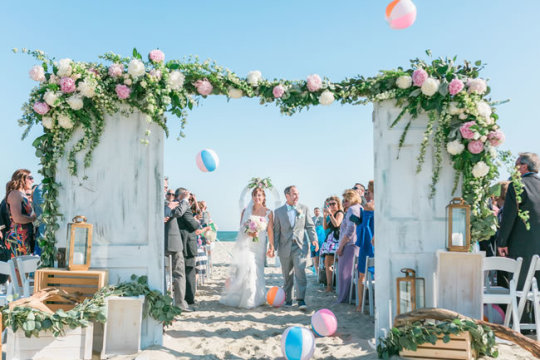
The Skinny on Summer Weather
Slap on that sunblock, because in nearly all parts of the country you can usually count on temps in the 70s (or higher!)—especially in the dog days of summer, like late July and August.
While sweet summertime means blue skies and balmy breezes most of the time, there are still some weather concerns to be aware of. For example, many east coast areas can experience torrential rain in the form of thunderstorms—soooo not ideal for an outdoor wedding! Then there's the south and southwest, where the thermometer can get up to 100 degrees fahrenheit or higher. An outdoor ceremony in this heat gives new meaning to the phrase, sweating for the wedding.
And, while less likely, there's the potential for natural disasters that can occur in the summer months. On the west coast, drought conditions frequently cause large-scale wildfires that bring hazy skies, poor air quality, and even evacuations. The opposite side of the country comes with the nasty Atlantic hurricane season, which begins June 1 and peaks in late August.
So…to play it safe, know what weather is forecasted for your wedding day, make sure to give your out-of-town guests whatever wardrobe tips they need to be prepared, and always—we repeat, ALWAYS—have a bad-weather backup plan. Just. in. case.

Summer Holidays
Besides fabulous weather, summer seems to be the least limiting in terms of holidays and other potential hiccups. While you won't have to compete with many major holidays, the months of June through July are some of the most popular times to get married AND go on vacation. You'll want to keep your guests' wallets in mind by giving them plenty of time to book flights and plan travel. Trust us, they'll thank you.
Here are a few dates to keep in mind:
Memorial Day – Always a Monday in May (Technically this is a spring holiday, but widely considered the unofficial start of summer)
Father's Day – Always a Sunday in June
Independence Day – Always July 4th, but days off can vary
Labor Day – Always a Monday in September
Hint: Save-the-dates for destination weddings typically get sent out 8–12 months in advance, while save-the-dates for local weddings can be sent out closer to 4 months in advance.
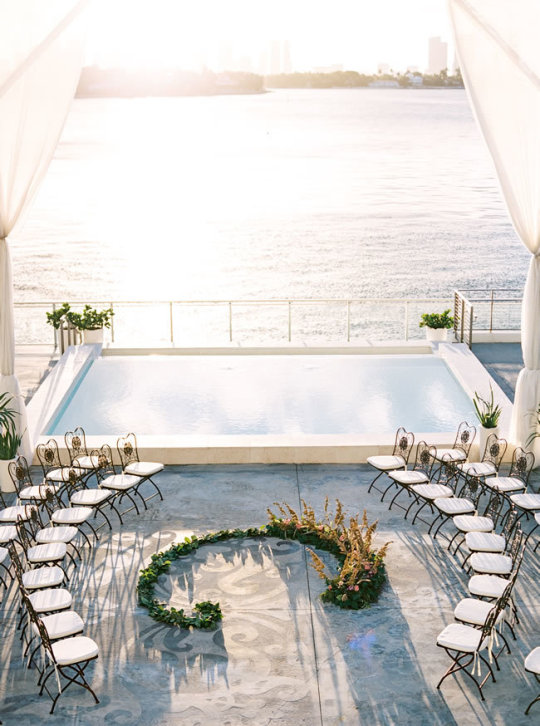
Summer Wedding Pros & Cons
There are so many advantages to getting married in the summer:
Typically gorgeous weather. Break out those sunnies!
There are fewer holidays to work around. Plus, it's widely considered PC to have an Independence Day or Labor Day weekend wedding.
The "Yes" RSVPs are more likely to roll in. Guests are often more willing and excited to take time off work and travel to a summer wedding!
Your outdoor venue and location choices are wide-open. Think barns, mountaintops and, of course, toes-in-the-sand beach weddings. The choices are endless!
However, there are a fair number of disadvantages to be aware of:
Summer is the most popular season to tie the knot. Venues and vendors often up their prices during this time, especially on weekends. Keep an eye out for peak-season rates when planning your wedding budget.
Destination wedding and honeymoon prices are also hitting their peak as most Americans book their vacation during the summer months.
Your favorite venues and vendors could be booked up months to years in advance for popular summer wedding dates.
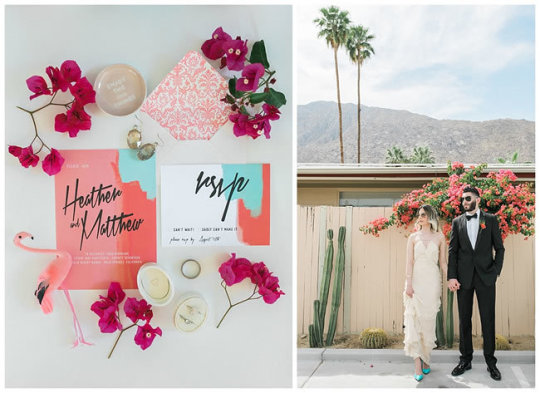
Summer Color Palette
Unlike other times of the year and their seasonal hues, the sunshine-filled days of summer complement nearly any wedding color palette. While you'll typically see bright colors at summer weddings, there's no need to shy away from deep blues, rich grays, or even black. Don't be afraid to think outside the box when it comes to putting together your own colors!

Bridesmaids and Groomsmen
When it comes to dressing your bridal party, comfort needs to be at the top of the list. If you're tying the knot in the Deep South in late July, chances are your 'maids and groomsmen won't appreciate being buried under layers of fabric and accessories. Consider shorter dresses or lighter fabrics, like organza or charmeuse.
For groomsmen, you'll want to be extra certain you won't be causing sweat overload before the ceremony has even started! Stick with lighter suit jackets and vests—or ditch the jackets altogether. Look into a variety of different hot-weather-friendly looks like khaki, rolled sleeves, suspenders, or even shorts and flip-flops!
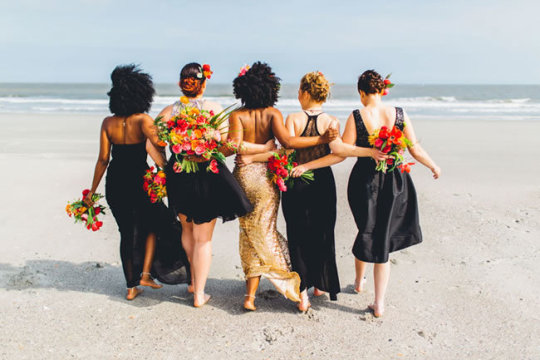
Working With What's In Season
When you buy what's in season, you get food and flowers at the peak of their supply when costs are normally lower. Plus, when they're locally grown they don't need to be shipped halfway around the globe. So not only do you save money, but you also reduce your carbon footprint. Win-win.
—Summer Wedding Food—
Much like spring, summer is peak harvesting season for fruits and vegetables. Summer's sunshine means there's no excuse to serve food that doesn't include a little color! As for veggies, the sky's the limit as to what's in season: green beans, cucumbers, eggplant, peas, and corn—just to name a few.
While fruit harvests are bountiful during this time of year, the weather can affect when they're ripest. Be on the lookout for melons, peaches, plums, raspberries, and blackberries because all of these are at their juiciest in the summer months. Fortunately, the abundance of produce in the summer can lead to lower prices, which is especially great if you're planning a farm-to-table wedding!
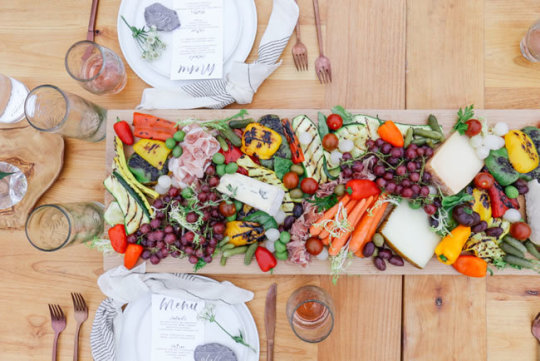
—Summer Wedding Flowers—
No matter where you are in the country, it seems that beautiful blooms are popping up all over the place. There are literally hundreds of options, but here are a few of our favorite summertime flowers:
Sunflowers. This classic is the poster child of summer, but we love how they add a pop of bright yellow to any bouquet.
Hydrangeas. These fluffy blossoms are summer staples that come in a wide variety of pretty colors.
Calla Lilies make a statement when bundled in a bouquet, and add a classy accent to any summer arrangement.
Amaranthus. From deep reds to fresh greens, this rope-like accent flower is perfect for boho or beach weddings, or even a more elegant affair!
Cacti. Use succulents like aloe and you can't go wrong.
Eucalyptus is a floral trend we're seeing year-round, and we're not complaining!
Pro Tip: Since some flowers are more prone to wilting in the summer heat than others, be sure to double-check with your florist before committing to any one flower or greenery.
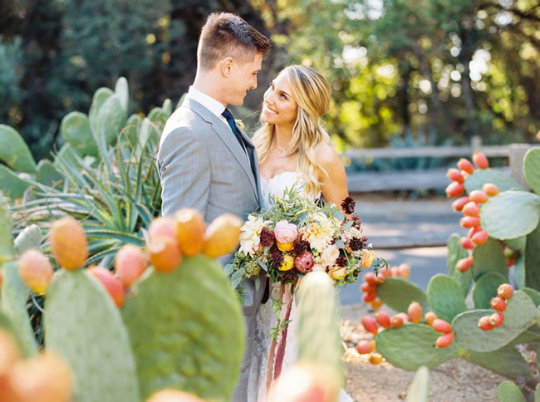
Summer Catering Trends
With a cornucopia of fresh fruits and veggies to choose from, you may have already started your search for the perfect hand-lettered sign to direct your guests to the salad bar. Not so fast! There are oh-so-many ways to pay homage to the tastes of the season, not all of which involve plants. If your personal faves include poultry, beef, and seafood, they can easily be incorporated into lighter versions of classics. Or, consider fun, non-traditional alternatives like tapas (Spanish small plates), a festive taco bar, or even good old-fashioned barbecue!
Your reception wouldn't be complete without a summer-inspired dessert! How about wine-flavored sorbet, yummy ice cream, or other frozen treats like snow cones, granita, or gelato to cool your guests down on those warm summer days! Or, what about a classic summer staple like cobbler or pie? There are so many options to choose from, so go wild!

Summer Wedding Cake Trends
Play with light and refreshing flavors like lemon, raspberry, and coconut instead of rich, fudgy chocolate—unless that's your thing, of course! If you're not into the "naked" cake trend, ice your cake with summery frostings that showcase coconut, cherry, or Tahitian vanilla. Dress it up with sprigs of lavender or rosemary, some gold leaf, or a pretty ombré pattern. The latest trend we're partial to? Colorful brush strokes paired with bright blooms. You could even ask if your baker is willing to collab with your florist to match your cake to your bouquet! Your wedding cake—assuming you even have one—should be as unique as you are!

Summer-Inspired Wedding Favors
Your guests will no doubt appreciate customized hand fans to keep cool or neon-colored sunnies to block summer's harsh rays. Or, hit up Old Navy's $1 Flip-Flop Sale to stock up on cheap sandals for tired feet to change into. You can also pick up miniature bottles of rosé, tiny potted succulents, homemade jam, and even travel-sized bottles of sunscreen with a custom sticker slapped on. And if you're really on a budget, how about some fresh seasonal fruit for your guests to enjoy?
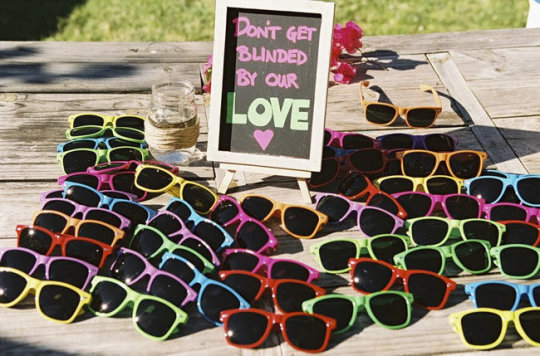
Summer Signature Cocktails
If you're serving cocktails on your big day, there's no better time to get creative than during the summer! Sparkling wines, champagne spritzers, and fruity cocktails are just the tip of the iceberg. Hit up your bartender (or just the drink-maker at your fave hangout spot!) for custom cocktails inspired by you and your fiancé. Refreshing berry mojitos, vodka-infused Arnold Palmers, boozy sangria, and mango bellinis—oh, yes! Just be sure to have water available for your guests at all times to keep them hydrated. Drink up!

#summer weddings#summer wedding planning#summer wedding ideas#wedding planning#wedding planning ideas
12 notes
·
View notes
Text
500 Drawing Prompts
waterfall
wizard's staff
zombies
sandcastle
fangs
tattoo
family crest
spaceship
mythical beast
spooky tree
alien
tropical cocktail
robot
dragon
tombstone
medieval goblets
king's throne
mermaid
vampire
witch's cauldron
tooth fairy
deep sea monster
magic carpet
sculpture
coral reef
wine bottle
statue of liberty
beast
beauty
elephant
Mayan ruins
birds
cameras
bowl of soup
breakfast
lunch
snack
dinner
flower vase
ladder
full moon
bright sun
autumn
summer
spring
winter
butterfly
caterpillar
troll
roller skates
rain boots
weeds
flowers
bedroom
kitchen
dining room
bathroom
egg hatching
wrist watch
night
harvest
pond
raincoat
hat
water bottle
flashlight
sailboat
dandelion
earthworm
bank robber
policeman
superhero
villain
view out a window
cactus
sunflower
mosquito
spider web
star fish
flip flops
lawn chair
trampolines
pots and pans
sword
lighthouse
pie on a windowsill
house plant
soldier
chimney
barbed wire
squirrels
hot sauce
chain
beehive
helicopter
hot dog
venus flytrap
stained glass
sphinx
skateboard
serenity
open book
werewolf
hourglass
tower
camel
Cleopatra
favorite book character
desert
forest
mountains
ocean
pumpkin seed
pine cone
octopus
mannequin
lollipop
something sticky
footprints
tractor
slime
island paradise
sand dune
archer
my favorite outfit
trophies
fishing fly
black hole
cyclops
swan
mirror
microphone
pretzels
newspaper
submarine
scrambled eggs
eel
wave
bike
leather boots
keys
coffee cup
self portrait
snake charmer
playground
sumo wrestler
crystal chandelier
eight ball
secrets
treasure chest
children's toy
something that sparkles
penguin
unicorn
pirate
tribal pattern
suit of armor
pinball machine
erupting volcano
seahorse
ninja
happy monster
futuristic car
three little pigs
magic amulet
yeti
toolbox
fish bones
zipper
carpenter
handcuffs
doll house
mask
telescope
piano
windmill
double sided axe
samurai
ghost
hot air balloon
bubbles
polka dots
plate of cookies
snake scales
pair of socks
high dive
belt
figure skater
fisherman
space
jack-o-lantern
Cinderella's glass slipper
hay bale
bumper cars
cover wagon
spy
fighter jet
parachute
tree bark
radio
art gallery
bow and arrow
pepperoni pizza
snail
bushel of apples
doorknob
talking object
harp
chess pieces
sprinkler
electricity
computer keyboard
presents
barn
plaid
jewelry
ballet
curtains
tripod
sunglasses
bow tie
Saturn's rings
birdcage
swap creature
horse and carriage
banana peel
stapler
toothpaste
thunder storm
movie poster
video game controller
cinnamon sticks
target
skull
elf
alien plant life
first love
new baby
kids jumping
glaciers
shark
scarf
wheelchair
blacksmith
four wheeler
cowboy
crossroads
pedestal
police car
pug
someone who is full of joy
what's under your bed
hieroglyph
dolphin
wooden shield
laughing
jump rope
desk
something big next to something small
taxi
staircase
tomahawk
hummingbird
hedgehog
gorilla
firetruck
soda can
teddy bear
fortune cookie
fruit basket
smirk
game of marbles
crumpled paper
swordfish
alarm clock
goldfish
puppet
salt and pepper shakers
jet pack
time machine
hands
wood fencing
cave mouth
milkshake
high heeled shoes
music
smile
mad scientist
telephone booth
skyscraper
gargoyle
diamond
sushi
brier patch
something that comes in pairs
box of chocolates
brick wall
bat
chicken
bonsai tree
headphones
a new typeface
jellyfish
candy canes
lawn mower
rain puddles
school
lamb
wolf
bed
bowl of popcorn
lampshade
peacock
turtle
bear
ceiling fan
yo-yo
oil spill
kite
invisible man
casino
Abraham Lincoln
ice cream cone
corn on the cob
claws
beekeeper
coins
watermelon
landing on the moon
rotary telephone
brain
rocks
needle in a haystack
picnic basket
fireplace
bottle of poison
genie in a bottle
knight
hammer
acorn
orange
owl
hair
wheel barrel
pyramids
exploding dynamite
shrimp
guitarist
keyboardist
drummer
singer
griffin
carousel horse
bunnies
puppies
board game
a famous painting
stone walkway
maple leaf
lizard
eyes
ears
nose
mouth
leopard
record player
bulldozer
bride
snowman
feather headdress
playing cards
windy day
sleeping bag
dancing skeleton
piggy bank
wizard
evil prince
lantern
beach ball
cherub
sprout
aircraft carrier
olympic swimmer
wedding dress
feather
baseball glove
noodles
cat
dog
happy
sad
angry
relaxed
graffiti
motorcycle
tornado
caveman
pineapple
Lock Ness monster
flag
gas mask
starry sky
dream house
deer
Goldilocks
frog
tadpole
swing
circus clown
earth
cupcake
lace
rocking chair
bravery
Big Ben
doctor
railroad car
parade
Christmas sweater
Ferris wheel
sci-fi gun
medicine cabinet
birthday party
cutlery
great wall of china
umbrella
traffic sign
catapult
light bulb
bamboo
heart
moon colony
sandwiches
juice box
lake house
bushes
hard candy
camouflage
platypus
football helmet
soccer game
balloons
astronaut
missing teeth
memory
jukebox
tulip
ladybug
birthday cake
t-shirt
igloo
golf ball
fossils
your least favorite food
pencil cup
half eaten apple
food with a face
horseshoe
daffodil
castle
tea party
scared
bag of chips
camping
cabin
bonfire
ship
watering can
palm tree
wind chimes
armchair
fireworks
knife
wine cork
waitress
farmer
fountain
last leaf on a tree
saber toothed tiger
grocery store
rainbow
typewriter
engine
bluebird
shooting star
a new invention
school of fish
bearded lady
secret garden
suspension bridge
viking artifact
Eiffel tower
a feast for a king
guitar
tree house
seashell
dinosaur
sea lion
Taj Mahal
your favorite animal in a tuxedo
39 notes
·
View notes
Text
Autumn Cocktails
Here is a list of seasonal tipples, to celebrate the red and gold foliage, to warm up after a walk on crisp leaves in the woods, to cheer up a rainy afternoon! These cocktails are a toast to Autumnal harvest and fragrant with the season’s flavours. Enjoy!
Harvest Flip (Gin)
Sparkling Pear (Vodka)
Pine Gin Toddy (Gin)
Applejack Rabbit (Apple Brandy)
Hot Buttered Rum (Rum)
Vampire Gin (Gin)
Cranberry Smash (Whisky)
Manhattan (Whisky)
Espresso Martini (Vodka)
Old Fashioned (Whisky)
Rosemary, June and Gin (Gin)
Goldwyn Follies (Gin)
Sakura Gin (Gin)
Ginger and Lime Whiskey (Whisky)
Maple Hot Toddy (Brandy)
Mapletini (Whisky)
Heated Affair (Tequila)
The Frankie Drake (Gin)
Sidecar (Brandy)
Bourbon Mulled Cider (Bourbon)
#Recipes#Drinks#Drink#Drink recipe#Autumn Cocktails#Autumn Cocktail recipes#Cocktails#Cocktail recipes#Gin Cocktail#Whisky Cocktail#Vodka Cocktail#Brandy Cocktail#Gin#Apple Brandy#Brandy#Cognac#Vodka#Whisky#Bourbon#Alcoholic#Alcoholic Drink#Alcoholic Beverage#Happy Hour#Autumn#Autumn recipe#Autumn recipes#Recipe List#Autumn Cocktails Recipe List#Recipe Box
5 notes
·
View notes
Text
hey i played rusty lake hotel and it was really good, i got the bundle so ill be doing the rest soon
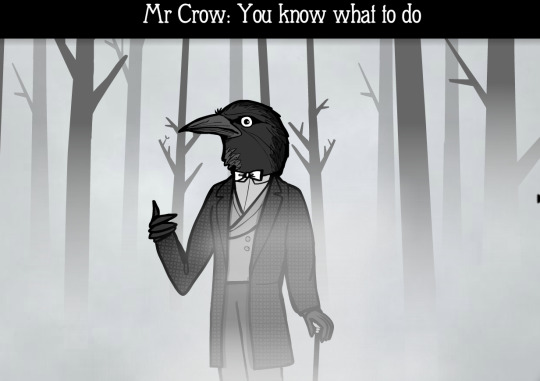
i LOVE this guy
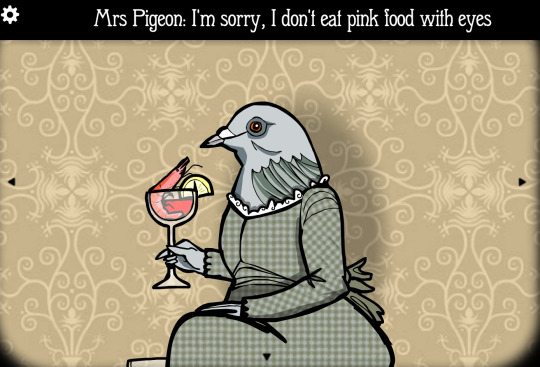
understandable
so we have a lovely hotel full of unnerving animal people, i was informed i was supposed to help prepare dinner,

,,,,oh
thats. all my recipes are. the animals who are currently guests. i. i see,
i went to explore upstairs and came across mr. deer’s room. i. assumed what i was going to have to do there, but did not realize:

ok you’re trapping me in here, alright
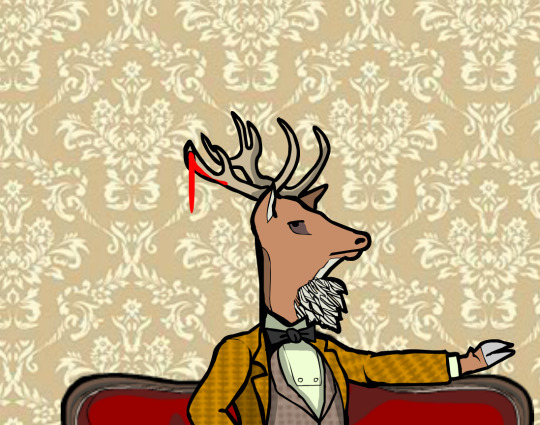
i found a knife but instead of just killing him with it the interaction caused me to stab him in the antler, which produces blood, which i could then use as part of the bloody mary he ordered (which i now have to figure out how to make without leaving this room. somehow)
he absolutely gave no reaction whatsoever to being stabbed or me harvesting blood from his fucking head for the bloody mary. i dont know if deer have nerves in their antlers or what but this strikes me as a very strange interaction
i also still don’t know why i can’t just stab him but apparently im solving a series of puzzles to create a poisoned bloody mary instead. right in front of him. after i just stabbed him a minute ago. seems like poisoning someone isn’t the best way to kill them if you have a knife on hand and you intend on harvesting that person’s meat for someone else’s consumption but what do i know
i am very much enjoying these puzzles though i got stuck a few times but it’s generally a pretty good balance of like “difficult enough that i feel like ive Accomplished Something when i figure it out”/”not so convoluted i just get frustrated” they’re mostly pretty standard logic puzzles or like. clever “look at it from a different perspective”/”Really Pay Attention, the solution is right there hiding in plain sight” kinda solutions i like it a lot
“solve a series of puzzles to figure out how to murder a group of people one by one” is a fantastic premise for a game

however, why the FUCK was there tabasco in this skull
and also why is mr. deer not concerned about the deer skull on the wall. i mean he wasnt concerned about me stabbing him and openly mixing poison two feet away from him but
could be that they’re not Really animals and it’s just a stylistic/symbolic thing maybe

this man watched me mix a bloody mary with his own blood and accepted it without batting an eye. alarming
i was also going to question whether bloody marys ACTUALLY have blood in them in the first place ( like. cow blood or whatever i know blood sausages are a thing so i figured I Guess It’s Possible) but then i actually wanted to know the answer to that question, which google tells me they’re actually mostly like, tomato juice and vodka among other not-blood things, which is what i thought,
anyway. theres all kinds of things wrong with this but somehow it worked. also the fact that the first thing this guy said to me was “hm, sorry I’m more of a meat person” when i offered him a shrimp cocktail suRE IS SOMETHING

nobody here takes issue with the fact that they’re being served meat from a fellow sentient species in this world, or that mr. deer mysteriously vanished in the night just before the deer meat was served. sure
again I’m thinking this might be a “they’re not Really animals it’s just a style/symbolic thing” situation bc it’d be way less likely for them to make the connection with the meat and the dude who disappeared if they weren’t really animals (also could’ve been told he checked out early or something)
nobody seems to get suspicious as this repeatedly happens, either. are they in on this. are they expecting it. do they Know. is this a whodunnit murder mystery from the perspective of the killer bc that’s excellent if so

oH GOD hello can i help you
fuckin rabbit grim reaper out there, ok

this was one of those things that immediately turns itself off when you flip the switch and i could tell i was supposed to do something with it and impulsively tried the knife on it and tHAT HAPPENED :’) SORRY. APPARENTLY I NEED THIS RING FOR SOMETHING

spooky
i like this rabbit dude hes the only one i actually feel bad about :’) (hes a normal rabbit man most of the time he just did a spooky skull trick for me bc he is a magician rabbit, which is adorable)
also i had a hell of a time trying to find the second optional ingredients for all of these i think i only found One and i have no idea where the rest of them were
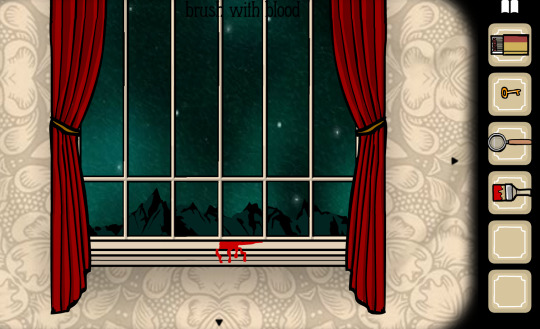
The Hand came back and i fuckign killed it again with the window i am so sorry :’)

this is going to be such a lovely portrait backdrop
ms pheasant takes no issue with me killing a disembodied hand in the window and using its blood to paint the backdrop for her either

hm. yes. very nice
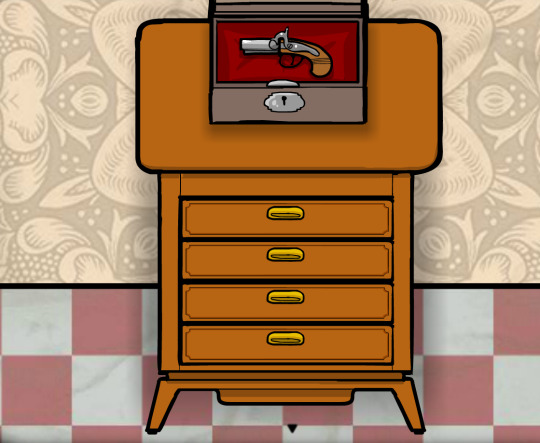
oh. well. that’s. pretty straight forward, i guess,

for some reason interacting with her with the gun makes her take it and she shoots herself during the camera flash????
i like the “shooting her” double meaning there but What Happened Here

sighs
i really, really did not want this to be the solution here but guess what
why did this happen. why was i put through this. is this my punishment for all these murders. having to witness this. why is this here. why didn’t he fucking NOTICE
also i dont know how the fuck mr boar died??? you give him the sandwich, he gets up to use the bathroom (which is an endless cycle of hell, by the way, it repeats if you don’t figure it out) and i just was clicking on stuff around the chair where he was sitting before bc i assumed him getting up meant something else was accessible now and i found like. a spot on the wall that looked slightly different and suddenly i had the boar meat????? what the fuck killed him
anyway what a bizarre experience this was i enjoyed it immensely except for that last part and am looking forward to the rest of them soon. i dont remember who recommended this but thank u very much
3 notes
·
View notes
Text
Wednesday, November 17, 2021 Canadian TV Listings (Times Eastern)
WHERE CAN I FIND THOSE PREMIERES?:
KENDRA SELLS HOLLYWOOD (discovery +)
THE MIGHTY UNDERDOGS (discovery +)
MARVEL’S HIT-MONKEY (Disney + Star)
WHAT IS NOT PREMIERING IN CANADA TONIGHT
FLIPPING SHOWDOWN (Premiering on November 28 on HGTV Canada at 9:00pm)
NEW TO AMAZON PRIME/CRAVE/NETFLIX CANADA/CBC GEM:
DISNEY + STAR
DOLLFACE (Season 1)
FANCY NANCY (Season 3)
NETFLIX CANADA
CHRISTMAS FLOW
PRAYERS FOR THE STOLEN
THE QUEEN OF FLOW (Season 2)
RIVERDALE (Season 6)
TEAR ALONG THE DOTTED LINE
TIGER KING 2
AHL HOCKEY (SN Now) 7:00pm: Laval Rocket vs. Toronto Marlies
NBA BASKETBALL
(SN1) 7:30pm: Pelicans vs. Heat
(SN Now) 7:30pm: Cavaliers vs. Nets
(TSN/TSN4) 7:30pm: Lakers vs. Bucks
(SN1) 10:00pm: Mavericks vs. Suns
WAR OF THE WORLDS (CBC) 8:00pm: Catherine, Sophia and Nathan are finally united with Bill and the group in London; as Catherine and Bill share their knowledge of the aliens they make a devastating realization about how the alien race came into existence in the first place.
SPIRIT TALKER (APTN) 8:00pm: Shawn tries his hand at the art of quilling and harvests some wild oysters with a local expert; through her private reading, a sister understands the night of her brother's tragic accident; a woman conquering her addictions finds renewed strength.
MY MISDIAGNOSIS (Super Channel Fuse) 8:00pm: In her teens, Samantha is told by doctors that the painful periods she was experiencing were nothing to worry about. Brett is a self-employed civil engineer that starts developing back pain, and the cocktail of medications affects his liver.
FIXER TO FABULOUS (HGTV Canada) 8:00pm/9:00pm (SEASON PREMIERE): Jenny and Dave give behind-the-scenes details as they reveal what really happened while helping a newly engaged couple expand their floor plan, overhaul the kitchen and transform the backyard to create an entertaining hot spot. In Episode Two, a couple bought a waterfront home with a panoramic view of the lake for their whole family to enjoy; Dave and Jenny have their work cut out for them as they turn this humdrum house into an artsy, kid-friendly home with its own indoor treehouse.
SKINDIGENOUS (APTN) 8:30pm: Lianna Spence is a 38-year-old Tsishiam artist from Prince Rupert who has recently picked up the art of tattooing; her beautifully detailed traditional designs have attracted a clientele from near and far.
NHL HOCKEY (SN) 9:00pm: Avalanche vs. Canucks
DIGGSTOWN (CBC) 9:00pm: Christian Spry Marcie represents a sexual assault victim in a human rights case after the police botch the investigation; Velma, Avery, and Rev. Cliff Crawley work together to right a 20-year-old wrong.
IN THE DARK (CTV2) 9:00pm: Things get awkward when Murphy and her friends ride out the storm together.
WE GOT LOVE TEYANA & IMAN (E! Canada) 10:30pm (SERIES PREMIERE): Teyana Taylor and Iman Shumpert take on the joys and challenges of growing an empire and a family; with Teyana's retirement from music and Iman's NBA career on hold, they turn their attention to their daughter Junie, who has ambitions of her own.
CFL FOOTBALL (TSN2) 11:00pm: Elks vs. Roughriders
#cdntv#cancon#canadian tv#canadian tv listings#war of the worlds#spirit talker#my misdiagnosis#skindigenous#diggstown#in the dark#ahl hockey#nba basketball#nhl hockey#cfl football
0 notes
Text
Next Round: Jordan Salcito Saw the Canned Cocktail Future

On this episode of “Next Round,” host Zach Geballe chats with Jordan Salcito, founder of Ramona, to discuss her pioneering canned Spritz brand. Salicto details her transition from working in hospitality, to becoming a sommelier, to finally starting her own brand. She explains how working in fine dining in New York and working harvests in Italy and Patagonia gave her the skills and knowledge she needed to launch Ramona.
Geballe explains that, though RTDs and canned wines are booming today, Ramona was one of the first brands to explore the trend of canned wine products when it came to market in 2016. Salcito explains how Ramona products fill a void in the market and reveals which new flavor Ramona is debuting this summer.
Tune in and visit https://www.drinkramona.com/ to learn more.
Listen Online
Listen on Apple Podcasts
Listen on Spotify
Or Check out the Conversation Here
Zach Geballe: From Seattle, Washington, I’m Zach Geballe. And this is a “VinePair Podcast” “Next Round” conversation. We bring you these episodes in between our regular podcasts so that we can explore a range of issues and stories in the drinks world. Today, I’m speaking with sommelier and founder of Ramona, Jordan Salcito. Thanks so much for taking the time.
Jordan Salcito: Thank you so much for including me in this episode. I’m very happy to be here.
Z: Yeah. I imagine that lots of our listeners are plenty familiar with Ramona, but they may not have been familiar with the backstory or your backstory. If you don’t mind, can you talk to us a little bit about how you got into the wine industry? Then, in particular, how and why this product, which at the time I think was pretty out there for what wine was going to be or a canned spritz. Now, we take this for granted since there’s an industry here so maybe just a backstory to start out.
J: Of course. I got into the wine industry accidentally while thinking that I wanted to pursue a career in writing about restaurants for The New York Times. I was cooking at the restaurant Daniel at the time. I think in retrospect, I hadn’t understood enough of the world to even dream about what working in wine could look like. Actually, the first time I really had a conversation with Daniel Boulud was after work one night. I had a sweet tooth and when you’re working on the line of a kitchen, you go for a long time without really eating. You don’t eat a meal sitting down ever. At least, nobody did back in those days. After service, before I would walk home, I would check in at the kitchen because the pastry team would always leave out delicious extra pastries. On this one particular night, I had a book with me, and coincidentally, Daniel Boulud walked in and he had a bottle of 1989 Jaboulet La Chapelle. He said, “Who are you, what’s your name, what are you doing here, and do you like wine?” He was so high-energy. Anyway, that led to Daniel being very curious. It was a thing that I always loved about that restaurant and about Daniel. He really values curiosity. He starts flipping through. At the time, one of my jobs was to wrap the black bass papillote and these potato scales. He stumbles upon a page of a dish, a red mullet with potato scales by Paul Marcus. It turns out that dish was the dish that inspired the signature dish that I was in charge of cooking. Anyway, Daniel poured a glass of this wine and we ended up talking for a long time. Ever since then, throughout the rest of my duration there, he really looked out for people who he could tell cared about and tried to give them an opportunity to do the thing that they were interested in doing. An opportunity came to work at the La Paulee des Neiges. It was this Burgundian wine event that was happening every year. With this one particular year, it was only happening in January in Aspen, Colo. I got the invitation to work this event and then I was told, “No, actually, we don’t have a budget for you.” I said, “If I can get myself there and work for free, can I do it?” They said, “Sure.” That was the moment for me where I was able to line up harvest in Burgundy for later that fall. My job during that particular harvest was really picking the grapes, being out in the vines every day for about two weeks straight. I remember by day eight or nine, I couldn’t stand up straight at the end of the day because you’re basically just hunched over carrying a bucket. A bucket of these wet, dripping grapes because 2006 was not a very sunny year during harvest, and it was truly backbreaking. It was also so revelatory, and it was amazing to be in the vineyards that I had read about and finally start to understand how the light hits a vineyard differently based on its exposure to the sun. How the insects that are in one vineyard are completely different from one a few yards over. That was when the practical application started to help the intellectual peace that you can read about in books. It’s when it all started coming together for me. Then, I would work in a winery after the picking because after the last grapes are picked, they’re still processing what is happening in the winery. I think that’s when it all just started coming together for me. I realized, after deciding to pursue this direction and wine, that the one true story I have of my own paternal grandfather, who I never met, is that he used to make wine in his basement with my dad. My grandfather died when my dad was 13 and so this is the one memory that my grandfather shared or that my father shares with my grandfather. It took years later to realize that there is this through-line for me of wine with this superpower ability to bring us together. To bring people together who might not have found themselves in a room or around a table otherwise. Even beyond that, and especially now with Covid, it’s amazing how we can feel a connection to a place by drinking a bottle of wine from there, and it’s almost as if we can transform ourselves. I think really it was that harvest that made me realize that I wanted to spend my life focused on wine in various ways. I started working harvest every year, usually in Burgundy. I would sometimes go to another region after that. I went to Tuscany, starting in 2008 after the harvest in Burgundy, and it was something that I loved to do. In 2007, I took a part-time sommelier position at Nick & Toni’s out in East Hampton. The owner or rather the general manager was a woman named Bonnie Munshin. She gave me a shot, and the person that was supposed to be full-time had a no-show on Memorial Day weekend. It was the best thing ever for me because it was a chance to step up but it was a natural disaster for her at the moment. She gave me this chance and that led to a full-time position at Eleven Madison Park after harvest that fall. I think what I started to realize is any time I would work in a restaurant, I would say, “Look, I just want you to know this thing that I do in the fall is harvest every year, and it will seem inconvenient for a week or so, but I promise you, I’ll come back and I’ll be a better sommelier. I’ll add value to the guests who come in here.” That proved to be true. I was able to develop this understanding of different approaches to production. There were some years where I couldn’t go to Burgundy because we were opening a new restaurant and it was 2011. I didn’t work a fall harvest that year, but I went to Patagonia Bodega Chacra the following February, and just the more I saw and noticed, the more through-lines I realized connected wines together with a value system. The delicious wines that I found really inspiring all had — whether the soil was slate or clay or limestone or whether the country was Italy, France, Germany, or Patagonia — there was this interesting through-line of wines that had a similar value system of transparency. Of course, prioritizing taste and deliciousness, but also it was more than that. Fast forward to 2015 when at that time I was overseeing the beverage programs for David Chang’s Momofuku restaurants. I began there in 2013, and the mandate that David gave me at the time was to build a wine program. People don’t really associate Momofuku with wine, and he wanted that to change. He understood there’s this community out there of wine people, and it’s not dissimilar to the community of chefs that he didn’t love. That was an amazing mandate. The other thing he said was, “You already know the rules, so now break them.” I think that permission was just this big breath of fresh air. Growing up, my mom had always prioritized the arts for my sisters and me. My dad’s a lawyer, so we had the pragmatic side, too. I think it was almost a permission to think like a child again in a good way. Permission to not be beholden to the machine. A lot of restaurants that are great and were great, there’s no room for any creativity or independent thought. You just have to be part of the machine in order for the system to work. This was different in a way that was so invigorating, and I remember having this idea that I wanted to call it Thunder Picho. I was reading a book by Paul Lukacs. He’s brilliant. He wrote a book called “American Vintage.” It’s one of my favorite books about wine, period. It basically tracks America’s relationship with wine and going all the way back to Thomas Jefferson and trying to plant Hermitage wines in Monticello and not realizing why they would die all the time. Then, fast forwarding to a sparkling Catawba was the first great American wine. Of course, phylloxera, when we realized that we could just graft onto American rootstock. Then, Prohibition and then World War I, followed by World War II. Actually, it was fascinating for me to read the similarities between the Mondavi family and the Gallo family. They had very different approaches. The Mondavi family was spearheaded by Robert Mondavi, who had gone to France and understood that there were these excellent French chateaux in Bordeaux and he wanted to model his winery and wine culture in America after that. Whereas you have Gallo, and they want to focus on data and give people what they want. You end up with Robert Mondavi starting to craft his legacy. At the same time, you have the Gallo brothers creating Thunderbird, which then became the No. 1 wine in the U.S. The ingredients were effectively white port with lemon juice concentrate. That’s so bad and terrible, but yet there’s something interesting. America has not yet figured it out. I think we’re getting there with globalization, Instagram, and conversation. It’s so exciting to see that now great wine is made everywhere and can be made anywhere with the value system in place. I think for me it was like, “Why?” I just thought that piece of history was interesting and then coupled that with moments in Italy harvest. I remember the first time I ever had an Aperol Spritz, and it was in the piazza of Montalcino in 2008 after a really dismal harvest, whereas the Burgundy harvest was picture perfect. Everyone’s been doing this for hundreds of years and the stories are amazing. Italy was the opposite for me. We were helping out my husband’s then-business partner, who was actually a bridge player, but had bought this estate in Montalcino and didn’t know anything about making wine. He said, “Hey, I have a tournament, can you guys just make this wine for me?” We didn’t even know what to do here. This is not something we’re qualified for, and we’re happy to help but please, nobody has any expectations here.” It was a very rainy year. The tractor fell over. There was no actual winery. We had a tarp that was over the sorting table and we were the only ones with a sorting table. We saw Burgundy do this and it’s really important so we thought we should try it here, too. Anyway, it was a very difficult harvest and the moment of respite was an afternoon Aperol Spritz and it was brightly colored and happy and not too bitter, but not too sweet. Fast forward to 2013-2014, what if we do some more digging here? What even is the wine cooler? I’ve never been a beer person. I’ve never found beer delicious, despite many college parties in which I wish that I had. I remember at some point when I was 21, somebody introduced me to wine coolers, and I was intrigued by them because they were less bad-tasting than cheap beer to me, to my palate. I think it took a lot of time for me to realize and just have confidence in my palate. At this point, I had passed the blind-tasting master sommelier exam. I was going this very educated route, and I felt that I can’t be the only person that still thinks beer is terrible, and there’s nothing out there. Now that I know enough about production, why is there not something meant for casual moments that I’m personally willing to consume? That was how the idea for Ramona started. I know that’s a very long-winded answer to your question, but yeah, that is basically the idea and the decision to start. It happened in 2015. We had just gotten the nomination for outstanding wine service at Co. I remember Bobby Stucky, who’s an amazing friend and mentor, had come in with his wife Donette and his general manager from Frasca. He’s also in charge of service at the Co, and he said the tasting menu that I just experienced at Co is the best I have had in recent memory. What you’re doing here is extraordinary, congratulations. Then, I remember a week after that is when I left for the master sommelier exam, and I had already passed the tasting. I had passed theory that year, which was the one I had been so nervous about, and I passed it in a way that finally felt so easy. I missed the service exam by one table, and it was a table of people who have never seen me work in a restaurant that I personally don’t know. The feedback that I was given was not that I ran out of time because I didn’t or that I didn’t answer the questions right because I had, it was that in their estimation, I didn’t seem like myself to them. It was just this one particular table, and I remember it was a big gut punch. It took me a little while to process it all. Then the next week, I found out I was pregnant with our son Henry, and that wasn’t planned. The universe decided that you thought you were going in this direction, but now your plans have changed. It was an opportunity to say, “Wait a minute, is the hill I’m going to die on trying to be more like myself to a group of people that don’t work in restaurants and never seen me work in a restaurant? Do I even want that feedback? Is there any way in which more work or more preparation could make me seem more like myself to a group of people who have no idea who I am or what I seem like?” That was an easy moment to course-correct and do this thing that I had felt was a void in the market for a while. The timing was good. The change was happening and I either could take some control over what that change would look like or not. And I chose the former.
Z: I want to follow up on one piece here, which is that you mentioned this idea that maybe your initial conception of Ramona was something that had a lineage that it shared with wine coolers. You saw it as a very casual drinking experience. Is that because from the jump you were thinking, “This is going to be a canned beverage?” Especially when you were probably thinking about the conception of what a wine-based product in a can was, there weren’t very many and they were definitely not seen as anything other than very casual beverages. Was it just the format that led you to that? Or since you wanted something casual, of course it’s going to go in a can?
J: Totally. It was more the latter, although cans were never obvious to me until we decided to go with them. It was more like a beverage. The beverage didn’t exist, and I just saw this big void. To your point about wine coolers, I would say that Ramona winks at wine coolers, but I would not say we were inspired directly.
Z: That is fair, I understand.
J: Yeah, wine coolers are a bad American version of spritz anyway. If you go down that rabbit hole, the ancient Romans and Greeks used to add water and flavorings to their wine. Nobody drank wine undiluted, so there is a fun lineage, if you want to go down that rabbit hole. As much as I was studying fine wine and as much as my life involved fine wine, what I found that I wanted to drink a lot of the time was something low in alcohol and refreshing and, in my estimation, was also delicious. Also, it adhered to a value system that was important to me. When I’d go out to the beach and have a lobster roll, the options were beer or a really cheaply made glass of rosé that I wasn’t interested in drinking. Then, to your point about wine coolers, I did some research and wine coolers were a massive category in the U.S. in the ‘80s, up until the early ‘90s. If you look at what happened, the beer lobby very sadly and successfully kneecapped wine coolers with a law that Congress passed in 1992, quintupling the excise tax on wine-based products in favor of malt. I love that Ramona was so early to the game, and I love that to this day because there are so many things in cans now. The thing that shocks me honestly is that I really want the rest of the canned industry to catch up and start producing things organically. If they’re *going to use malt, which is a horrible industry because everything is sugar cane-based. I know a lot more about that than I should because of my sister, who runs an NGO that pushes multinational corporations to respect human rights. There’s an opportunity for businesses to make decisions that impact the world on a positive note, and I hope we see more of that. As far as cans go, initially, my vision for this was that they would be in a bottle. Yet, the more I started researching and the more that I wanted to really lean into how we as a business make decisions that I’m proud of, aluminum is the most recycled material — above glass, above plastic, above anything. On top of that, it has a much lower carbon footprint than tracking glass all over or plastic all over. It felt like the right environmental decision. It was risky because I remember people saying, “Look, nobody’s going to know where to put this on the shelf” and “Where does this even go?” I think it was fortuitous that there was enough of a groundswell among cans as a vessel, and that was something that worked out for us. However, I would be lying if I said that the vision was always the can. The vision was always the product inside of the can. The can just made the most sense in terms of alignment with our value system.
Z: I think what’s interesting about the Ramona products is that they have, in my experience, adhered pretty close to this idea of very classic Italian spritz, at least in terms of their flavor profile. I’m sure that there have been times, suggestions, and maybe even prototypes of something outside this very citrus-centric flavor profile. Have you come close to expanding? What stops you if you have? Or are you just very content with the core flavor set?
J: Good question. This is actually a good lead-in to our flavor that we will be releasing this summer.
Z: Oh, I didn’t even know about this. Breaking news here on the podcast.
J: Breaking news, exactly. I just had a production call this morning. I wish we were going to release it sooner, but it looks like it’s probably going to be July. This remains true, but my goal is always, “How we can make things that I, as a very particular consumer, am willing and excited to drink regularly?” One way that we took inspiration was from that Aperol Spritz. The most natural way to do that back when I was tinkering with recipes was through grapefruit as a flavor, because it is both bitter, sweet, and a little salty. It’s also balanced and refreshing, so that’s where we started working with an extract made from organic grapefruits. Then really to that point, if that’s our inspiration for this particular flavor profile, what are the other flavor profiles that we want to consider? Then, it was just a whole bunch of tinkering. The thing we always lead with is, what is delicious? Of course, delicious is subjective, but what is delicious to us and what is missing. That led us to produce lemon from organic Sicilian lemons. We did a test batch here in the U.S., and that’s where I was introduced to a chemical called velcorin. I was told we could use velcorin and this was on canning day. I had spent my savings on everything, and it took a year to get to this point. Then, I learned on canning day that the canning facility wants to use velcorin or potassium sorbate to make them shelf-stable. In potassium sorbate, there’s a known carcinogen on the Whole Foods no-fly list and I just knew I didn’t want to touch that. Of course, I said, what about sterile filtration? What about all these other things? Those were not options at this particular moment in time. Anyway, this was when I learned what velcorin was. It’s a neurotoxin for the first 24 hours. It has to be administered with a hazmat suit. It is growing in popularity and does not have to be disclosed. What I’ve learned from my friends in Napa is that a lot of natural wines will just nuke the wine with velcorin, and nobody has to know, and then it doesn’t explode on the shelf. In Italy, we moved production and the definitive factor for me was how do we not have to use something weird like this? In Italy, we just pasteurize a wine in warm water. That’s when I became really committed to working with Italian ingredients, and Italy has its fair share of problems and frustrations. However, one thing they are going to prioritize is what they eat and what they drink. There’s just so much emphasis on that, which I really love and respect, and that’s how we ended up with Meyer Lemon. As we were tinkering, we definitely had recipes in the works for berry-flavored things. At the end of the day, it had to be delicious. That’s how we landed on Blood Orange, but then we didn’t release a new flavor. Last year, we did the Dry Grapefruit which is the drier, slightly lower in alcohol, 90-calorie version of the ruby grapefruit. However, I had a recipe that I have been tinkering with and working on for a very long time. Instead of taking its inspiration from southern Italy and Sicily, it takes its inspiration from northern Italy and Venice. Basically, the Aperol Spritz, minus the FD&C Red 40, minus the cold tar, minus the 279 grams of sugar per liter. Aperol as a brand is brilliant. Aperol as a product is just so fun and brightly colored. I say Aperol, but Aperol is part of its own lineage that emerged during the Italian futurist art movement, which I just learned. The futurist art movement actually produced the Russian constructivist movement, which our label design is inspired by. This notion that fine art belongs to everyone and it can be on a poster and it can be in an alley. It doesn’t have to live in a gold frame in a museum. That was the reason for Ramona. You can be at the beach, you can be on a hike, you can have a sandwich, you can be at home or you can be at a restaurant, and you can have a beverage for this any type of moment that adheres to a value system of a lot of these great wines. So, our new flavor is called Amarino. Basically, “ino” means a little bit of Amaro, and it’s bitter and it is this beautiful bright color. It is orange in color, with a bitter orange peel, and bitter oranges being a major profile, but it’s a recipe with a lot of different layers and we will finally be able to release that in the summer.
Z: Excellent. I have a couple of other questions for you. On “Next Round,” we’ve interviewed and talked to lots of people about sommeliers and other restaurant professionals who have either actually done what you’ve done to some extent or are intrigued by this idea of creating a product, creating a brand, and leaving the restaurant industry. You talked about this before, this moment in your career, this inflection point where things went one way instead of another. Do you miss the restaurant life? Can you go away, or is it still a siren song for you?
J: For me, I was able to achieve what I set out to achieve, and I had an amazing set of experiences through the restaurant world. It’s amazing how I remember being terrified of parenthood, and there were so many skills that actually just translated over really well. You’re already used to not sleeping very much. You’re already used to doing things ambidextrously and eating out of a quart container really fast.
Z: Also, used to lots and lots of complaining.
J: Yes, lots of complaining. Nothing ever goes the way that you think it will. You just get used to pivoting and thinking on your feet. I would say for me, it coincided perfectly with the evolution of my life, my family’s needs, and my own desire to be more present. My son Henry was born in January 2016. I had never intended to use maternity leave to focus on Ramona, but I found I had to. As restaurant people, we are busy all the time. We’re used to doing many things at once, and a baby sleeps a lot.
Z: Yeah, that is true.
J: I had a lot of time to really focus on what it is that I want. The most important question is, “Am I doing a thing that fills a genuine need?” With any decision that we make, whether it’s a flavor or anything, what is the reason behind it? Why are we doing this? Does the world need this thing? Do we believe in what we’re doing? Are we adding to the conversation or are we just doing something that already exists? That’s something we try to be really considerate of, but I think as far as restaurants, I was really fortunate to work in them during a period of my life where it really made a lot of sense for my life. My husband was in the restaurant industry at the time. He is no longer as of a couple of years ago, but it was just part of life. I think it probably shifted mid- to late-2015, where the things that I hoped to be able to do, I have been able to achieve. It was time for a new adventure and a new journey. I believe I had a full life in restaurants, but I don’t miss the floor.
J: Gotcha. And one last question for you, Jordan. Speaking of additional things you’re doing, you also have a podcast — you’re a veteran of this medium — called “Opening Up.” Can you talk a little bit about how that came to be? I’m led to believe that there’s another season coming, is that right?
J: Yes, exactly. “Opening Up” launched last September, and we decided to limit it to 10 episodes and ensure that it goes back to that through-line of wine as this connective tissue. There are so many wonderful people that have fallen in love with wine and have their own stories to tell. It was something that I had hoped to do for a while and had been on the table in conversations for a while. Then last year with Covid, it really needed to launch then, because that was a moment where nobody was seeing anybody they didn’t live with. It was an opportunity to really have these conversations from wherever we were. I loved and appreciated the opportunity to have those conversations. As we were trying to figure out the cadence, we decided we do want to have our seasons launch in the fall, and I like to think of Ramona as season-less. However, our busiest seasons tend to be spring and summer, so it’s a really nice way to ease into fall and winter and just to stay in touch with people who also love wine.
Z: Very cool. It definitely seems from a few episodes I listened to that the wine is the nominal point of connection for you and the guest. It is definitely not a conversation exclusively about wine, which, given the interesting set of people you have on, is very cool.
J: Oh, thank you.
Z: I mean, not that there’s any shortage of podcasts out there. You all should be listening to all of our VinePair podcasts for one, but this is definitely worth checking out as well — especially because I know some of you out there have more commute times ahead of you as people actually go back to work. Jordan, I really want to thank you for your time. It’s been a pleasure to talk to you and hear a little bit about this pioneering product. Some of the other people out there making canned wine products may not even be aware of the debt they owe Ramona. I think you guys really showed that you could do this in that format and have it be both delicious and also taken seriously. I think that was a big hurdle for canned wine products to get over because, as I mentioned before, it was definitely not the case five, six years ago when you guys launched.
J: Zach, thank you so much for these kind words and really for the opportunity to be part of this conversation and to be part of the program and also meet your listeners in this way. It’s been a pleasure. I have a great deal of respect for you and what you have built. I am really happy to have the time to connect here.
Thanks so much for listening to the “VinePair Podcast.” If you love this show as much as we love making it, then please give us a rating or review on iTunes, Spotify, Stitcher, or wherever it is you get your podcasts. It really helps everyone else discover the show.
Now for the credits, VinePair is produced and recorded in New York City and in Seattle, Wash., by myself and Zach Geballe, who does all the editing and loves to get the credit. Also, I would love to give a special shout-out to my VinePair co-founder, Josh Malin, for helping make all this possible and also to Keith Beavers, VinePair’s tastings director who is additionally a producer on the show. I also want to, of course, thank every other member of the VinePair team who are instrumental in all of the ideas that go into making the show every week. Thanks so much for listening, and we’ll see you again.
Ed. note: This episode has been edited for length and clarity.
The article Next Round: Jordan Salcito Saw the Canned Cocktail Future appeared first on VinePair.
Via https://vinepair.com/articles/jordan-salcito-ramona-canned-cocktails/
source https://vinology1.weebly.com/blog/next-round-jordan-salcito-saw-the-canned-cocktail-future
0 notes
Text
Next Round: Jordan Salcito Saw the Canned Cocktail Future

On this episode of “Next Round,” host Zach Geballe chats with Jordan Salcito, founder of Ramona, to discuss her pioneering canned Spritz brand. Salicto details her transition from working in hospitality, to becoming a sommelier, to finally starting her own brand. She explains how working in fine dining in New York and working harvests in Italy and Patagonia gave her the skills and knowledge she needed to launch Ramona.
Geballe explains that, though RTDs and canned wines are booming today, Ramona was one of the first brands to explore the trend of canned wine products when it came to market in 2016. Salcito explains how Ramona products fill a void in the market and reveals which new flavor Ramona is debuting this summer.
Tune in and visit https://www.drinkramona.com/ to learn more.
Listen Online
Listen on Apple Podcasts
Listen on Spotify
Or Check out the Conversation Here
Zach Geballe: From Seattle, Washington, I’m Zach Geballe. And this is a “VinePair Podcast” “Next Round” conversation. We bring you these episodes in between our regular podcasts so that we can explore a range of issues and stories in the drinks world. Today, I’m speaking with sommelier and founder of Ramona, Jordan Salcito. Thanks so much for taking the time.
Jordan Salcito: Thank you so much for including me in this episode. I’m very happy to be here.
Z: Yeah. I imagine that lots of our listeners are plenty familiar with Ramona, but they may not have been familiar with the backstory or your backstory. If you don’t mind, can you talk to us a little bit about how you got into the wine industry? Then, in particular, how and why this product, which at the time I think was pretty out there for what wine was going to be or a canned spritz. Now, we take this for granted since there’s an industry here so maybe just a backstory to start out.
J: Of course. I got into the wine industry accidentally while thinking that I wanted to pursue a career in writing about restaurants for The New York Times. I was cooking at the restaurant Daniel at the time. I think in retrospect, I hadn’t understood enough of the world to even dream about what working in wine could look like. Actually, the first time I really had a conversation with Daniel Boulud was after work one night. I had a sweet tooth and when you’re working on the line of a kitchen, you go for a long time without really eating. You don’t eat a meal sitting down ever. At least, nobody did back in those days. After service, before I would walk home, I would check in at the kitchen because the pastry team would always leave out delicious extra pastries. On this one particular night, I had a book with me, and coincidentally, Daniel Boulud walked in and he had a bottle of 1989 Jaboulet La Chapelle. He said, “Who are you, what’s your name, what are you doing here, and do you like wine?” He was so high-energy. Anyway, that led to Daniel being very curious. It was a thing that I always loved about that restaurant and about Daniel. He really values curiosity. He starts flipping through. At the time, one of my jobs was to wrap the black bass papillote and these potato scales. He stumbles upon a page of a dish, a red mullet with potato scales by Paul Marcus. It turns out that dish was the dish that inspired the signature dish that I was in charge of cooking. Anyway, Daniel poured a glass of this wine and we ended up talking for a long time. Ever since then, throughout the rest of my duration there, he really looked out for people who he could tell cared about and tried to give them an opportunity to do the thing that they were interested in doing. An opportunity came to work at the La Paulee des Neiges. It was this Burgundian wine event that was happening every year. With this one particular year, it was only happening in January in Aspen, Colo. I got the invitation to work this event and then I was told, “No, actually, we don’t have a budget for you.” I said, “If I can get myself there and work for free, can I do it?” They said, “Sure.” That was the moment for me where I was able to line up harvest in Burgundy for later that fall. My job during that particular harvest was really picking the grapes, being out in the vines every day for about two weeks straight. I remember by day eight or nine, I couldn’t stand up straight at the end of the day because you’re basically just hunched over carrying a bucket. A bucket of these wet, dripping grapes because 2006 was not a very sunny year during harvest, and it was truly backbreaking. It was also so revelatory, and it was amazing to be in the vineyards that I had read about and finally start to understand how the light hits a vineyard differently based on its exposure to the sun. How the insects that are in one vineyard are completely different from one a few yards over. That was when the practical application started to help the intellectual peace that you can read about in books. It’s when it all started coming together for me. Then, I would work in a winery after the picking because after the last grapes are picked, they’re still processing what is happening in the winery. I think that’s when it all just started coming together for me. I realized, after deciding to pursue this direction and wine, that the one true story I have of my own paternal grandfather, who I never met, is that he used to make wine in his basement with my dad. My grandfather died when my dad was 13 and so this is the one memory that my grandfather shared or that my father shares with my grandfather. It took years later to realize that there is this through-line for me of wine with this superpower ability to bring us together. To bring people together who might not have found themselves in a room or around a table otherwise. Even beyond that, and especially now with Covid, it’s amazing how we can feel a connection to a place by drinking a bottle of wine from there, and it’s almost as if we can transform ourselves. I think really it was that harvest that made me realize that I wanted to spend my life focused on wine in various ways. I started working harvest every year, usually in Burgundy. I would sometimes go to another region after that. I went to Tuscany, starting in 2008 after the harvest in Burgundy, and it was something that I loved to do. In 2007, I took a part-time sommelier position at Nick & Toni’s out in East Hampton. The owner or rather the general manager was a woman named Bonnie Munshin. She gave me a shot, and the person that was supposed to be full-time had a no-show on Memorial Day weekend. It was the best thing ever for me because it was a chance to step up but it was a natural disaster for her at the moment. She gave me this chance and that led to a full-time position at Eleven Madison Park after harvest that fall. I think what I started to realize is any time I would work in a restaurant, I would say, “Look, I just want you to know this thing that I do in the fall is harvest every year, and it will seem inconvenient for a week or so, but I promise you, I’ll come back and I’ll be a better sommelier. I’ll add value to the guests who come in here.” That proved to be true. I was able to develop this understanding of different approaches to production. There were some years where I couldn’t go to Burgundy because we were opening a new restaurant and it was 2011. I didn’t work a fall harvest that year, but I went to Patagonia Bodega Chacra the following February, and just the more I saw and noticed, the more through-lines I realized connected wines together with a value system. The delicious wines that I found really inspiring all had — whether the soil was slate or clay or limestone or whether the country was Italy, France, Germany, or Patagonia — there was this interesting through-line of wines that had a similar value system of transparency. Of course, prioritizing taste and deliciousness, but also it was more than that. Fast forward to 2015 when at that time I was overseeing the beverage programs for David Chang’s Momofuku restaurants. I began there in 2013, and the mandate that David gave me at the time was to build a wine program. People don’t really associate Momofuku with wine, and he wanted that to change. He understood there’s this community out there of wine people, and it’s not dissimilar to the community of chefs that he didn’t love. That was an amazing mandate. The other thing he said was, “You already know the rules, so now break them.” I think that permission was just this big breath of fresh air. Growing up, my mom had always prioritized the arts for my sisters and me. My dad’s a lawyer, so we had the pragmatic side, too. I think it was almost a permission to think like a child again in a good way. Permission to not be beholden to the machine. A lot of restaurants that are great and were great, there’s no room for any creativity or independent thought. You just have to be part of the machine in order for the system to work. This was different in a way that was so invigorating, and I remember having this idea that I wanted to call it Thunder Picho. I was reading a book by Paul Lukacs. He’s brilliant. He wrote a book called “American Vintage.” It’s one of my favorite books about wine, period. It basically tracks America’s relationship with wine and going all the way back to Thomas Jefferson and trying to plant Hermitage wines in Monticello and not realizing why they would die all the time. Then, fast forwarding to a sparkling Catawba was the first great American wine. Of course, phylloxera, when we realized that we could just graft onto American rootstock. Then, Prohibition and then World War I, followed by World War II. Actually, it was fascinating for me to read the similarities between the Mondavi family and the Gallo family. They had very different approaches. The Mondavi family was spearheaded by Robert Mondavi, who had gone to France and understood that there were these excellent French chateaux in Bordeaux and he wanted to model his winery and wine culture in America after that. Whereas you have Gallo, and they want to focus on data and give people what they want. You end up with Robert Mondavi starting to craft his legacy. At the same time, you have the Gallo brothers creating Thunderbird, which then became the No. 1 wine in the U.S. The ingredients were effectively white port with lemon juice concentrate. That’s so bad and terrible, but yet there’s something interesting. America has not yet figured it out. I think we’re getting there with globalization, Instagram, and conversation. It’s so exciting to see that now great wine is made everywhere and can be made anywhere with the value system in place. I think for me it was like, “Why?” I just thought that piece of history was interesting and then coupled that with moments in Italy harvest. I remember the first time I ever had an Aperol Spritz, and it was in the piazza of Montalcino in 2008 after a really dismal harvest, whereas the Burgundy harvest was picture perfect. Everyone’s been doing this for hundreds of years and the stories are amazing. Italy was the opposite for me. We were helping out my husband’s then-business partner, who was actually a bridge player, but had bought this estate in Montalcino and didn’t know anything about making wine. He said, “Hey, I have a tournament, can you guys just make this wine for me?” We didn’t even know what to do here. This is not something we’re qualified for, and we’re happy to help but please, nobody has any expectations here.” It was a very rainy year. The tractor fell over. There was no actual winery. We had a tarp that was over the sorting table and we were the only ones with a sorting table. We saw Burgundy do this and it’s really important so we thought we should try it here, too. Anyway, it was a very difficult harvest and the moment of respite was an afternoon Aperol Spritz and it was brightly colored and happy and not too bitter, but not too sweet. Fast forward to 2013-2014, what if we do some more digging here? What even is the wine cooler? I’ve never been a beer person. I’ve never found beer delicious, despite many college parties in which I wish that I had. I remember at some point when I was 21, somebody introduced me to wine coolers, and I was intrigued by them because they were less bad-tasting than cheap beer to me, to my palate. I think it took a lot of time for me to realize and just have confidence in my palate. At this point, I had passed the blind-tasting master sommelier exam. I was going this very educated route, and I felt that I can’t be the only person that still thinks beer is terrible, and there’s nothing out there. Now that I know enough about production, why is there not something meant for casual moments that I’m personally willing to consume? That was how the idea for Ramona started. I know that’s a very long-winded answer to your question, but yeah, that is basically the idea and the decision to start. It happened in 2015. We had just gotten the nomination for outstanding wine service at Co. I remember Bobby Stucky, who’s an amazing friend and mentor, had come in with his wife Donette and his general manager from Frasca. He’s also in charge of service at the Co, and he said the tasting menu that I just experienced at Co is the best I have had in recent memory. What you’re doing here is extraordinary, congratulations. Then, I remember a week after that is when I left for the master sommelier exam, and I had already passed the tasting. I had passed theory that year, which was the one I had been so nervous about, and I passed it in a way that finally felt so easy. I missed the service exam by one table, and it was a table of people who have never seen me work in a restaurant that I personally don’t know. The feedback that I was given was not that I ran out of time because I didn’t or that I didn’t answer the questions right because I had, it was that in their estimation, I didn’t seem like myself to them. It was just this one particular table, and I remember it was a big gut punch. It took me a little while to process it all. Then the next week, I found out I was pregnant with our son Henry, and that wasn’t planned. The universe decided that you thought you were going in this direction, but now your plans have changed. It was an opportunity to say, “Wait a minute, is the hill I’m going to die on trying to be more like myself to a group of people that don’t work in restaurants and never seen me work in a restaurant? Do I even want that feedback? Is there any way in which more work or more preparation could make me seem more like myself to a group of people who have no idea who I am or what I seem like?” That was an easy moment to course-correct and do this thing that I had felt was a void in the market for a while. The timing was good. The change was happening and I either could take some control over what that change would look like or not. And I chose the former.
Z: I want to follow up on one piece here, which is that you mentioned this idea that maybe your initial conception of Ramona was something that had a lineage that it shared with wine coolers. You saw it as a very casual drinking experience. Is that because from the jump you were thinking, “This is going to be a canned beverage?” Especially when you were probably thinking about the conception of what a wine-based product in a can was, there weren’t very many and they were definitely not seen as anything other than very casual beverages. Was it just the format that led you to that? Or since you wanted something casual, of course it’s going to go in a can?
J: Totally. It was more the latter, although cans were never obvious to me until we decided to go with them. It was more like a beverage. The beverage didn’t exist, and I just saw this big void. To your point about wine coolers, I would say that Ramona winks at wine coolers, but I would not say we were inspired directly.
Z: That is fair, I understand.
J: Yeah, wine coolers are a bad American version of spritz anyway. If you go down that rabbit hole, the ancient Romans and Greeks used to add water and flavorings to their wine. Nobody drank wine undiluted, so there is a fun lineage, if you want to go down that rabbit hole. As much as I was studying fine wine and as much as my life involved fine wine, what I found that I wanted to drink a lot of the time was something low in alcohol and refreshing and, in my estimation, was also delicious. Also, it adhered to a value system that was important to me. When I’d go out to the beach and have a lobster roll, the options were beer or a really cheaply made glass of rosé that I wasn’t interested in drinking. Then, to your point about wine coolers, I did some research and wine coolers were a massive category in the U.S. in the ‘80s, up until the early ‘90s. If you look at what happened, the beer lobby very sadly and successfully kneecapped wine coolers with a law that Congress passed in 1992, quintupling the excise tax on wine-based products in favor of malt. I love that Ramona was so early to the game, and I love that to this day because there are so many things in cans now. The thing that shocks me honestly is that I really want the rest of the canned industry to catch up and start producing things organically. If they’re *going to use malt, which is a horrible industry because everything is sugar cane-based. I know a lot more about that than I should because of my sister, who runs an NGO that pushes multinational corporations to respect human rights. There’s an opportunity for businesses to make decisions that impact the world on a positive note, and I hope we see more of that. As far as cans go, initially, my vision for this was that they would be in a bottle. Yet, the more I started researching and the more that I wanted to really lean into how we as a business make decisions that I’m proud of, aluminum is the most recycled material — above glass, above plastic, above anything. On top of that, it has a much lower carbon footprint than tracking glass all over or plastic all over. It felt like the right environmental decision. It was risky because I remember people saying, “Look, nobody’s going to know where to put this on the shelf” and “Where does this even go?” I think it was fortuitous that there was enough of a groundswell among cans as a vessel, and that was something that worked out for us. However, I would be lying if I said that the vision was always the can. The vision was always the product inside of the can. The can just made the most sense in terms of alignment with our value system.
Z: I think what’s interesting about the Ramona products is that they have, in my experience, adhered pretty close to this idea of very classic Italian spritz, at least in terms of their flavor profile. I’m sure that there have been times, suggestions, and maybe even prototypes of something outside this very citrus-centric flavor profile. Have you come close to expanding? What stops you if you have? Or are you just very content with the core flavor set?
J: Good question. This is actually a good lead-in to our flavor that we will be releasing this summer.
Z: Oh, I didn’t even know about this. Breaking news here on the podcast.
J: Breaking news, exactly. I just had a production call this morning. I wish we were going to release it sooner, but it looks like it’s probably going to be July. This remains true, but my goal is always, “How we can make things that I, as a very particular consumer, am willing and excited to drink regularly?” One way that we took inspiration was from that Aperol Spritz. The most natural way to do that back when I was tinkering with recipes was through grapefruit as a flavor, because it is both bitter, sweet, and a little salty. It’s also balanced and refreshing, so that’s where we started working with an extract made from organic grapefruits. Then really to that point, if that’s our inspiration for this particular flavor profile, what are the other flavor profiles that we want to consider? Then, it was just a whole bunch of tinkering. The thing we always lead with is, what is delicious? Of course, delicious is subjective, but what is delicious to us and what is missing. That led us to produce lemon from organic Sicilian lemons. We did a test batch here in the U.S., and that’s where I was introduced to a chemical called velcorin. I was told we could use velcorin and this was on canning day. I had spent my savings on everything, and it took a year to get to this point. Then, I learned on canning day that the canning facility wants to use velcorin or potassium sorbate to make them shelf-stable. In potassium sorbate, there’s a known carcinogen on the Whole Foods no-fly list and I just knew I didn’t want to touch that. Of course, I said, what about sterile filtration? What about all these other things? Those were not options at this particular moment in time. Anyway, this was when I learned what velcorin was. It’s a neurotoxin for the first 24 hours. It has to be administered with a hazmat suit. It is growing in popularity and does not have to be disclosed. What I’ve learned from my friends in Napa is that a lot of natural wines will just nuke the wine with velcorin, and nobody has to know, and then it doesn’t explode on the shelf. In Italy, we moved production and the definitive factor for me was how do we not have to use something weird like this? In Italy, we just pasteurize a wine in warm water. That’s when I became really committed to working with Italian ingredients, and Italy has its fair share of problems and frustrations. However, one thing they are going to prioritize is what they eat and what they drink. There’s just so much emphasis on that, which I really love and respect, and that’s how we ended up with Meyer Lemon. As we were tinkering, we definitely had recipes in the works for berry-flavored things. At the end of the day, it had to be delicious. That’s how we landed on Blood Orange, but then we didn’t release a new flavor. Last year, we did the Dry Grapefruit which is the drier, slightly lower in alcohol, 90-calorie version of the ruby grapefruit. However, I had a recipe that I have been tinkering with and working on for a very long time. Instead of taking its inspiration from southern Italy and Sicily, it takes its inspiration from northern Italy and Venice. Basically, the Aperol Spritz, minus the FD&C Red 40, minus the cold tar, minus the 279 grams of sugar per liter. Aperol as a brand is brilliant. Aperol as a product is just so fun and brightly colored. I say Aperol, but Aperol is part of its own lineage that emerged during the Italian futurist art movement, which I just learned. The futurist art movement actually produced the Russian constructivist movement, which our label design is inspired by. This notion that fine art belongs to everyone and it can be on a poster and it can be in an alley. It doesn’t have to live in a gold frame in a museum. That was the reason for Ramona. You can be at the beach, you can be on a hike, you can have a sandwich, you can be at home or you can be at a restaurant, and you can have a beverage for this any type of moment that adheres to a value system of a lot of these great wines. So, our new flavor is called Amarino. Basically, “ino” means a little bit of Amaro, and it’s bitter and it is this beautiful bright color. It is orange in color, with a bitter orange peel, and bitter oranges being a major profile, but it’s a recipe with a lot of different layers and we will finally be able to release that in the summer.
Z: Excellent. I have a couple of other questions for you. On “Next Round,” we’ve interviewed and talked to lots of people about sommeliers and other restaurant professionals who have either actually done what you’ve done to some extent or are intrigued by this idea of creating a product, creating a brand, and leaving the restaurant industry. You talked about this before, this moment in your career, this inflection point where things went one way instead of another. Do you miss the restaurant life? Can you go away, or is it still a siren song for you?
J: For me, I was able to achieve what I set out to achieve, and I had an amazing set of experiences through the restaurant world. It’s amazing how I remember being terrified of parenthood, and there were so many skills that actually just translated over really well. You’re already used to not sleeping very much. You’re already used to doing things ambidextrously and eating out of a quart container really fast.
Z: Also, used to lots and lots of complaining.
J: Yes, lots of complaining. Nothing ever goes the way that you think it will. You just get used to pivoting and thinking on your feet. I would say for me, it coincided perfectly with the evolution of my life, my family’s needs, and my own desire to be more present. My son Henry was born in January 2016. I had never intended to use maternity leave to focus on Ramona, but I found I had to. As restaurant people, we are busy all the time. We’re used to doing many things at once, and a baby sleeps a lot.
Z: Yeah, that is true.
J: I had a lot of time to really focus on what it is that I want. The most important question is, “Am I doing a thing that fills a genuine need?” With any decision that we make, whether it’s a flavor or anything, what is the reason behind it? Why are we doing this? Does the world need this thing? Do we believe in what we’re doing? Are we adding to the conversation or are we just doing something that already exists? That’s something we try to be really considerate of, but I think as far as restaurants, I was really fortunate to work in them during a period of my life where it really made a lot of sense for my life. My husband was in the restaurant industry at the time. He is no longer as of a couple of years ago, but it was just part of life. I think it probably shifted mid- to late-2015, where the things that I hoped to be able to do, I have been able to achieve. It was time for a new adventure and a new journey. I believe I had a full life in restaurants, but I don’t miss the floor.
J: Gotcha. And one last question for you, Jordan. Speaking of additional things you’re doing, you also have a podcast — you’re a veteran of this medium — called “Opening Up.” Can you talk a little bit about how that came to be? I’m led to believe that there’s another season coming, is that right?
J: Yes, exactly. “Opening Up” launched last September, and we decided to limit it to 10 episodes and ensure that it goes back to that through-line of wine as this connective tissue. There are so many wonderful people that have fallen in love with wine and have their own stories to tell. It was something that I had hoped to do for a while and had been on the table in conversations for a while. Then last year with Covid, it really needed to launch then, because that was a moment where nobody was seeing anybody they didn’t live with. It was an opportunity to really have these conversations from wherever we were. I loved and appreciated the opportunity to have those conversations. As we were trying to figure out the cadence, we decided we do want to have our seasons launch in the fall, and I like to think of Ramona as season-less. However, our busiest seasons tend to be spring and summer, so it’s a really nice way to ease into fall and winter and just to stay in touch with people who also love wine.
Z: Very cool. It definitely seems from a few episodes I listened to that the wine is the nominal point of connection for you and the guest. It is definitely not a conversation exclusively about wine, which, given the interesting set of people you have on, is very cool.
J: Oh, thank you.
Z: I mean, not that there’s any shortage of podcasts out there. You all should be listening to all of our VinePair podcasts for one, but this is definitely worth checking out as well — especially because I know some of you out there have more commute times ahead of you as people actually go back to work. Jordan, I really want to thank you for your time. It’s been a pleasure to talk to you and hear a little bit about this pioneering product. Some of the other people out there making canned wine products may not even be aware of the debt they owe Ramona. I think you guys really showed that you could do this in that format and have it be both delicious and also taken seriously. I think that was a big hurdle for canned wine products to get over because, as I mentioned before, it was definitely not the case five, six years ago when you guys launched.
J: Zach, thank you so much for these kind words and really for the opportunity to be part of this conversation and to be part of the program and also meet your listeners in this way. It’s been a pleasure. I have a great deal of respect for you and what you have built. I am really happy to have the time to connect here.
Thanks so much for listening to the “VinePair Podcast.” If you love this show as much as we love making it, then please give us a rating or review on iTunes, Spotify, Stitcher, or wherever it is you get your podcasts. It really helps everyone else discover the show.
Now for the credits, VinePair is produced and recorded in New York City and in Seattle, Wash., by myself and Zach Geballe, who does all the editing and loves to get the credit. Also, I would love to give a special shout-out to my VinePair co-founder, Josh Malin, for helping make all this possible and also to Keith Beavers, VinePair’s tastings director who is additionally a producer on the show. I also want to, of course, thank every other member of the VinePair team who are instrumental in all of the ideas that go into making the show every week. Thanks so much for listening, and we’ll see you again.
Ed. note: This episode has been edited for length and clarity.
The article Next Round: Jordan Salcito Saw the Canned Cocktail Future appeared first on VinePair.
source https://vinepair.com/articles/jordan-salcito-ramona-canned-cocktails/
0 notes
Text
How To Dry Fresh Mint Leaves | 3 Different Ways

Written by Sass Ayres
Drying your own herbs is a great way to preserve the season and have access to quality herbs all year round. It can help to prevent food waste when you have more herbs than you can use and is especially helpful with herbs that are voracious growers… like mint! Learning how to dry mint is simple, takes very little hands-on time, and gives you an end product that has an incredibly wide variety of uses. Mint tea, anyone?
READY TO DRY SOME MINT?! HERE YOU’LL FIND:
The Health Benefits of Mint
When to Harvest Mint for Drying
Open-Air Drying Mint – 2 ways
Using a Dehydrator to Dry Mint
Drying Mint in the Oven
How to Store & Use Dried Mint
The Health Benefits of Mint
Mint is an incredible plant medicine. While we most often see peppermint used in medicine due to its high concentration of menthol, all mints contain some menthol and they can largely be used interchangeably in both food & medicine.
Mint is carminative in nature, meaning it helps to ease digestion so that we can more smoothly and efficiently digest our food, absorbing more of its nutrients. Peppermint oil capsules are a common herbal remedy for digestive upset like gas and bloating, indigestion, and painful stomach cramping.
It’s also anti-inflammatory, anti-microbial, and is a delicious gently stimulating nervine. A cup of mint tea in the afternoon is a great pick-me up. It’s way less jolting to our nervous system than coffee and a caffeine-free option with added medicinal benefits.
When Should You Harvest Mint?
The best time to harvest any plant is when it’s at its prime, the height of its nutritional and medicinal content. With mint, you can harvest the first flush as soon as it’s green and vibrant in the spring. Mint will continue to re-grow after you harvest, possibly providing several opportunities to harvest throughout the growing season.
When harvesting mint for drying, it’s best to harvest early in the morning before the sun hits the plants. Mint is most lively after a night’s rest and before the stress of the day.
Also try to avoid harvesting after rain, as there tends to be so much water on the plants. When drying herbs, less water on the surface of the plants is better and can help to prevent frustrating molding situations.
However, if you must harvest after rain, just do your best to dry as much of the water from the surface of the plants as possible.
Some also prefer to wash the mint before drying to get rid of any bugs or dirt that may be on the leaves. I prefer not to do this unless the leaves are visibly covered in dirt. Instead, I prefer to just take a bundle at a time and give it a good shake (like you’re shaking out a paint brush) and a few brushes with my hands.
If you do prefer to wash your mint before drying, just be sure to lay the mint out on a towel to dry as much of the water off as possible, especially if bundling for open-air drying.

How to Dry Fresh Mint Leaves
There are a few different ways to dry fresh mint. The equipment, space/environment, and time you have available to you is helpful in deciding which method will work best for you.
Here’s how to dry mint in 3 easy ways:
How to Open-Air Dry Mint
In drying mint out in the open air, it’s important that the mint is left in a dry environment (the lower the humidity, the better) and out of direct sunlight. The open-air method of drying fresh mint leaves can be done one of two basic ways.
Open-Air Method #1: Bunch the sprigs of mint together and hang to dry.
Bundle the mint together, making sure your bundles aren’t so large or dense so as to cause poor air circulation. (Drier environments with lower humidity can handler larger, denser bundles. Otherwise, mold becomes a concern.)
Use rubber bands instead of twine. As the mint wilts and dries, the twine will likely loose its grip, whereas the rubber band can contract with the mint as it dries.
Hang the bundles in a dry space out of direct sunlight. You can hang them inside or outside under a covered porch. Above a wood-burning stove is another great place to hang herbs to dry.
Depending on the environmental conditions, this method can take up to 10-14 days. Although, I’ve had some herbs dry in as little as 4-5 days in really dry conditions.
Open-Air Method #2: Lay the sprigs of mint out in a single layer in an open-air drying rack such as this adorable DIY one that uses old picture frames.
Just spread the mint sprigs out in a single layer, leaving plenty of room for good air circulation.
This method seems to go a little faster than bundling the mint, most likely because of better air flow. Plan for at least 5-7 days to allow the mint to dry completely.
Once you’re sure the mint is dry, next comes my favourite part! Garbling!
Garbling Your Dried Herbs
Garbling is an old-fashioned technical term used by herbalists and is simply the process of stripping the leaves from the stem, of separating the good parts from the unwanted or undesirable parts.
Essentially, holding the spring of mint on the tip, use your other hand to lightly pinch the sprig between your thumb and forefinger and run it down the length of the stem. The dried leaves should separate from the stem with ease.

How to Dry Mint with a Dehydrator
Using a dehydrator, you could dry mint in as little as 3-5 hours. Simply, pluck the leaves from the stems and arrange them on the dehydrator trays in a single layer. (Discard/compost the stems.)
Set the dehydrator to 105℉ (40℃) and allow to dry thoroughly. Check on the leaves after a few hours. Once dry, allow to cool completely before storing them otherwise, the condensation from the heat may cause the mint to mold.
Sometimes while the leaves are still a little warm, it’s hard to tell if they’re completely dry. If the aren’t entirely dry after they cool completely, just put them back in the dehydrator for another hour or so.
How to Dry Mint in the Oven
Using the oven to dry mint is very similar to the dehydrator method, only you’ll lay the mint out on a cookie sheet instead of a dehydrator tray and you’ll need to give the leaves or stems a tussle or turn a few times so that they dry evenly.
For this reason, I prefer to leave the leaves on the stem to make turning them easier. Although, you can remove the leaves to dry it you prefer. It does seem to take a little longer to dry on the stem, but it saves me the hands-on time of having to flip individual leaves.
Turn the oven to 105℉ (40℃), prop the oven door open the tiniest bit (a pot holder or even a wooden spoon is helpful for this), turn the leaves or stems every hour or so, and then remove once completely dry (~3-5 hours).
As in the dehydrator method, allow the leaves to cool completely before storing. And if you kept the leaves on the stem, once completely dry, garble as you would have in the open-air method.

How to Store Dried Mint
First and foremost, it’s imperative to ensure that your mint is entirely dry before processing and storing. You’ll know the mint is completely dry when the leaves easily crinkle and crunch between your fingertips.
If uncertain, just use your senses. Mint that is not completely dry will be softer, won’t crunch and crinkle between your fingers, and is oftentimes a different color than completely dry mint. If you’re still uncertain, there’s no harm in leaving it to dry a little a longer.
Store the dried leaves in lidded glass jars, in a dry place out of direct sunlight and away from heat. If stored properly, dried mint can last 6 months to a year. The older it gets, the less potent it becomes in smell and taste, as well as both nutritionally and medicinally.
Uses for Dried Mint Leaves
Oh, the many ways to use dried mint! Here’s a few:
Mint tea or minty herbal tea blends (Try these!)
Herbal cocktails (like this Ginger Mint Hot Toddy or this Wild Spring Vodka Mojito)
Make bug spray
Make a non-toxic cleaning spray
Try making your own peppermint extract with vodka and dried peppermint.
Sprinkle a little on fresh fruit or coconut yogurt.
Bake with it! (Try the Peppermint Mocha pie in Holiday Pies from the (Un)Bakery.)
And the list could go on. In whatever way you choose to use mint, I hope you find the process of drying your own mint empowering and fun.
https://www.botanyculture.com/how-to-dry-fresh-mint-leaves/
0 notes